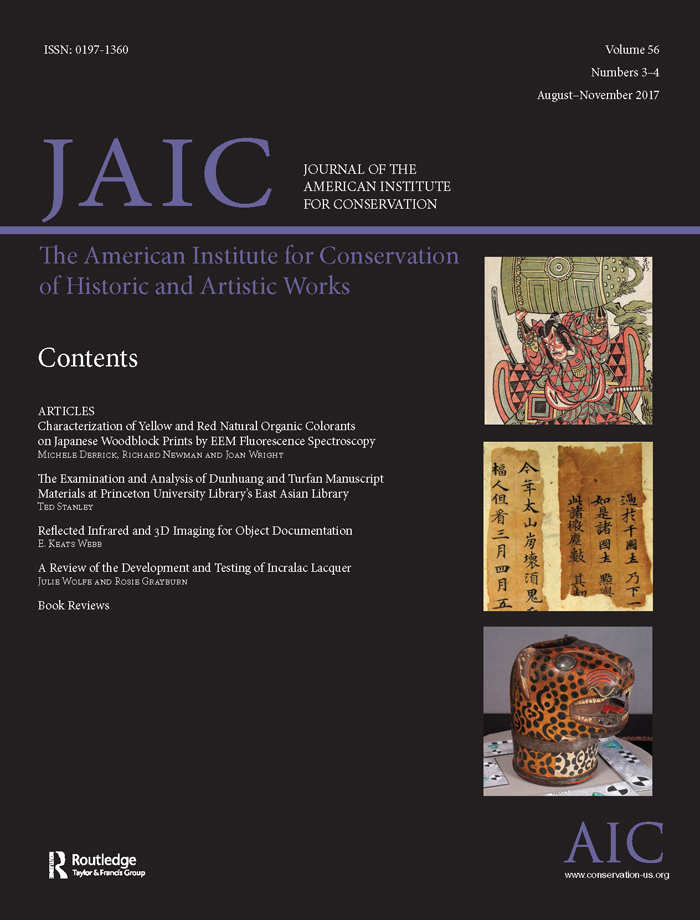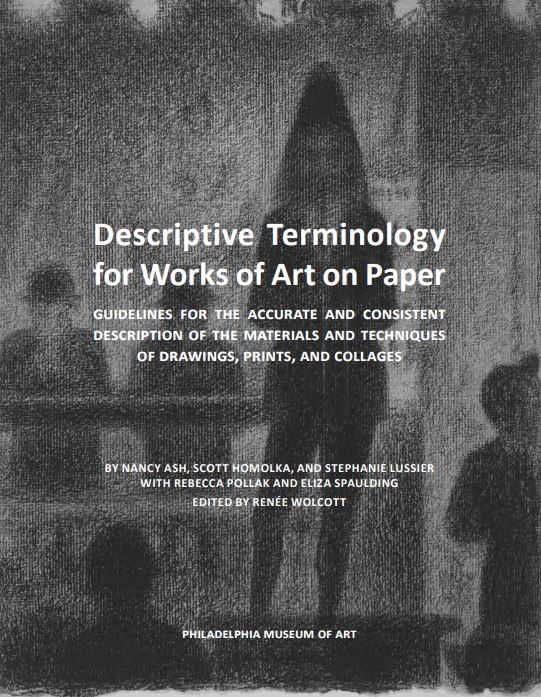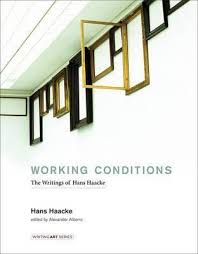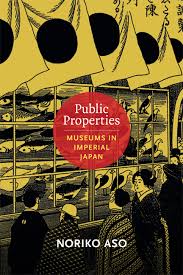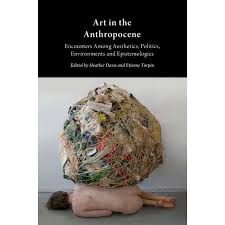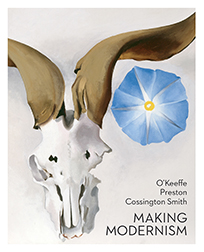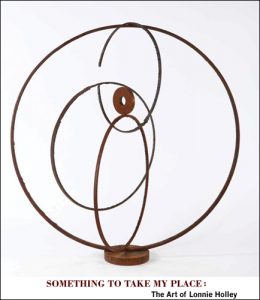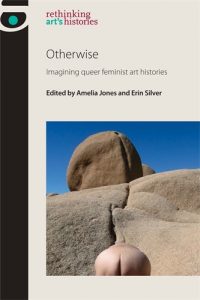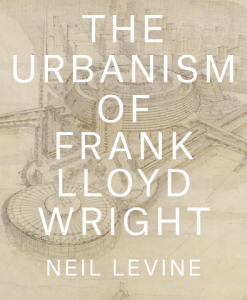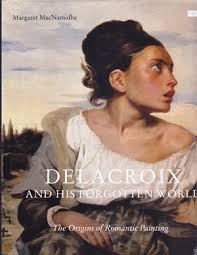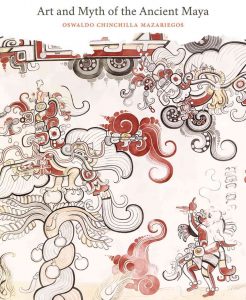CAA News Today
An Interview with Roberto Tejada, CAA’s New Vice President for Diversity and Inclusion
posted by CAA — Jun 05, 2018
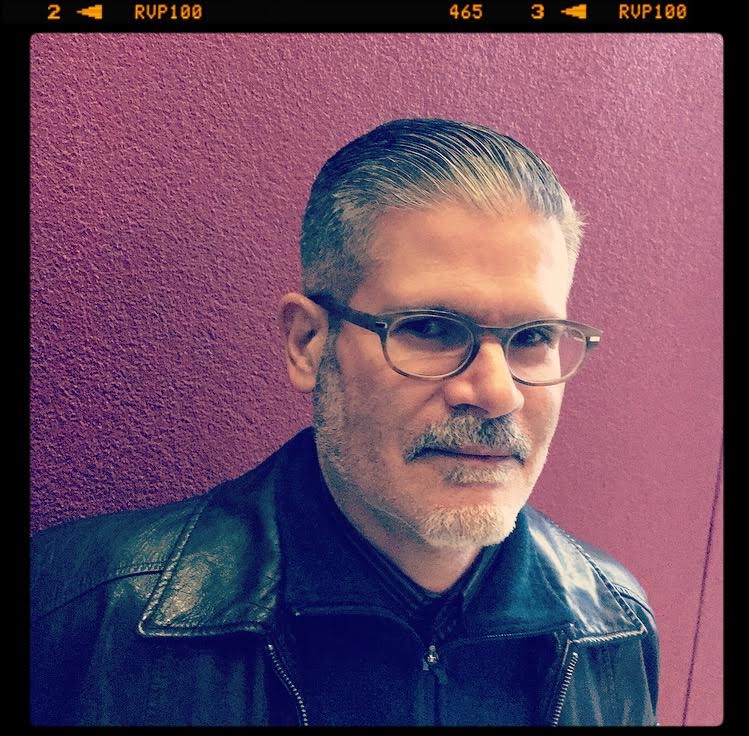
Roberto Tejada
Last week, Roberto Tejada, CAA’s newly elected vice president for diversity and inclusion, talked with Hunter O’Hanian, CAA’s executive director, about the state of the field and why achieving true diversity is so difficult in the arts field.
The interview accompanies CAA’s newly created Values Statement on Diversity and Inclusion, adopted by the CAA board of directors in May 2018.
Hunter O’Hanian: You were elected as CAA’s first vice president for diversity and inclusion last October. Can you tell me why that position was created and what you hope to accomplish?
Roberto Tejada: Let me answer that first with a confession. I joined CAA as an emerging professional many years ago, newly positioned in academia, but not altogether of academia. I’d spent a decade of my formal and informal working years in the art and literary worlds of 1990s Mexico City. When I returned to the US, there were few art history PhD programs with faculty specializing in Latin American and US Latinx art; the art-related disciplines were not especially open or inclusive, and the CAA and its conference consistently felt to me like alienating spaces. So I was never much engaged as a member.
A few years ago, in 2013-2014, I had the opportunity to be in attendance at a CAA retreat held at Clark Art Institute, where I was a fellow. I listened to CAA’s leadership in discussions that led to the drafting of its current strategic plan; and I was impressed with the various commitments among its stakeholders to issues of advocacy and questions of diversity and inclusion. Those conversations inspired me to consider it was possible to effect change from within, so I agreed to put myself forward and was elected by the board in 2016 to serve as Secretary.
My understanding was that CAA’s membership had long sought leadership, whether on the board or staff, to embody, energize, and encourage a commitment to diversity and inclusion at every level of the organization. Under review were resolutions that resulted from the perseverance of CAA’s Committee on Diversity Practices, other subcommittees, and the efforts of many individual members, including the “Resolution to Create a New Officer with the Title of Vice President for Diversity and Inclusion” and the “Resolution Adopting a Values Statement on Diversity and Inclusion.”
Why was the position was created? It’s no secret that the membership of scholarly associations is in decline and that cultural institutions more broadly jeopardize their relevance and sustainability when they fail to make diversity and inclusion central to an organization’s structuring values. For the last decades, cultural life and fields of study have been categorically redefined by the art and scholarship of underrepresented groups; by artists and intellectuals of color, LGBT scholars, and others who have faced the challenges of institutional spaces, often without networks of support.
Also, insofar as the language of diversity and inclusion readily serves the neoliberal agenda, it’s conveniently adopted and used by universities and other organizations as a cover for actual equity in terms of race, ethnicity, skin color, and other social markers of difference, visible and invisible. The promotion of diversity and inclusion involves redressing an entanglement of past narratives but with a steady eye on the present and future. One way to view it, appropriate to art and design, is as a work-in-progress. CAA has been watchful of currents in higher education and the arts and it has led advocacy efforts of great impact for diversity and inclusion. If equity and inclusion were to become the priority issue for CAA and its membership, the human and intellectual vibrancy of our respective institutions could begin to more accurately reflect the plural narratives that have led to the composition of contemporary society. I’m passionate about the role that the board and membership can play to empower others, and so change the faces of CAA.
But in the context of current political discourses in the government and media, the challenge of advancing equity in the arts and humanities is to move beyond the model of appealing to hearts and minds, and to encourage policy-change guidelines that are concrete channels to access.
HO: What particular issues do you see in the fields of art history and visual arts with regard to diversity, either in the academic world or museums? A high percentage of CAA’s members are white. Is there a reason for that?
RT: Despite the multicultural context of the so-called global turn, the fields of art history and the visual arts have not been particularly hospitable to persons deemed different. If you serve on enough admission and hiring committees at different kinds of institutions, you cannot ignore the implicit biases that continue to perpetuate a lack of equity. Although fields of research and curricula have adapted to account for plural histories, the bodies that make art and design, that care and write about practices, history, preservation, and display at universities and museums, are still overwhelmingly white. It’s challenging to recruit emerging professionals of color who feel underrepresented in CAA. Members within the organization, however, have effected change. For example, the US Latinx Art Forum (USLAF) is an affiliated society that was formed by CAA members, and it now includes around 300 artists, art historians, curators, and other art professionals. Its founders Adriana Zavala and Rose G. Salseda, responded to “ongoing marginalization of US Latinx art within the academy and specifically within both ‘American’ and ‘Latin American’ art history.” USLAF’s members advocate for scholarship at the intersections of Latinx, African-American, Asian-American and Indigenous art and art histories. Its efforts are positioned to inspire artists and scholars of color to join and participate in CAA.
HO: In May, the CAA board of directors passed its Values Statement on Diversity and Inclusion. Why this particular statement now?
RT: That statement was a collaborative effort that resulted from discussions first among members of the Committee for Diversity Practices; then among board members, who voted to pass the statement. The statement will strike many as belated. As a starting point, it has been retroactively amended to the Strategic Plan and will serve as a guiding frame of reference for all CAA initiatives and actions moving forward.
HO: What can practitioners/educators in the field do to help diversify their own departments or student cohorts?
RT: Flora Brooke Anthony, Chris Bennett, and Katherine Brion facilitated an excellent workshop at the last CAA Annual Conference in Los Angeles on the “disconnect between intention and practice” and on why faculty hiring guides and administrative initiatives have been unsuccessful at creating diverse departments. Some of the short answers have to do with the professional pipeline, implicit bias, the comfort zone idea of “best fit,” and the social factors to do with accumulation of advantage and disadvantage. The long view requires challenging our membership to lend efforts and energies in the service of inclusion that actually enhances one’s research imagination at the departmental level and in the classroom. There are resources on CAA’s website: standards and guidelines for diversity practices, links to a database on multicultural teaching, digital resources with classroom ideas, archives of digitized imagery, and bibliographies of global visual culture. There are ways that practitioners and educators in art and art history departments can partner with units and other departments on campus whose faculty and graduate student research addresses the scope of human diversity and the structures of exclusion or discrimination. Departments can explore the possibility of creating residency fellowship for recent MFAs or PhDs who bring different embodied experiences. There are CAA-sponsored web platforms to be explored that could serve to link emerging professionals and graduate student to create an open space for questions and concerns relevant to faculty of color in departments unfamiliar with diversity needs. Department can actively recruit from diverse universities and community colleges, with an openness to candidates with experiences and expertise not always associated with the arts.
It’s important to remember as well that students and professionals of color at different stages of a career path often complain that so-called target opportunities are experienced and perceived as marginalizing, empty appeals to special treatment that once again delegitimizes the actual merits and recognition of excellence among underrepresented future scholars, designers, artists, curators and other museum professionals.
HO: Do you see movements, changes and trends on the national level that is making diversity work easier or more difficult?
RT: I think there is enough evidence to discern that the rhetoric fueling racial fears and resentment against minorities, enabled nationally and internationally by those in power, is inclined to have ripple effects in academia and in the arts. It has entitled attitudes and actions that have made the need to advocate for diversity and inclusion all the more urgent.
For more on CAA’s advocacy efforts, click here.
Click here to access the CAA Arts and Humanities Advocacy Toolkit.
News from the Art and Academic Worlds
posted by CAA — May 30, 2018
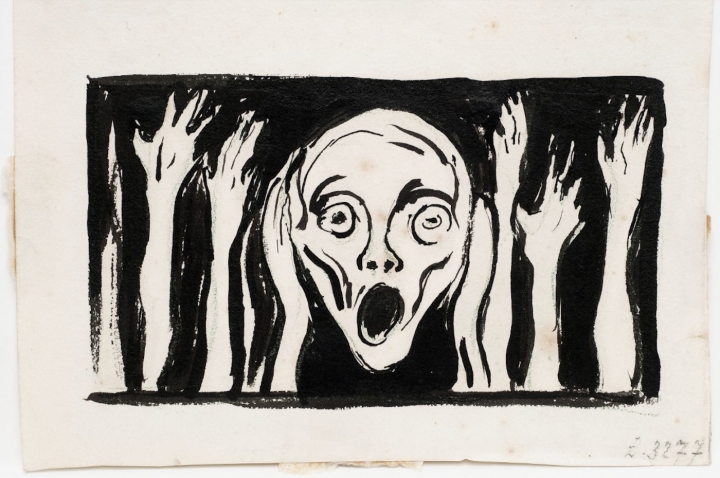
Edvard Munch, “Scream” Head and Raised Arms, ca 1898, via the Munch Museum website.
Amid Debate Over MOCA’s Future, Director Philippe Vergne Will Depart
The museum and director decided “by mutual agreement” not to renew Vergne’s contract when it expires in March 2019. (artnet News)
Return Persian Antiquity to Iran, New York District Attorney Says
The ancient limestone relief was seized from a London antiquities dealer last October. (The Art Newspaper)
Design Thinking Is a Boondoggle
“We shouldn’t pretend that we can boil education — indeed, all of human life — into a five-point diagram for selling stuff.” (Chronicle of Higher Education)
7,600 Edvard Munch Drawings Now Available to Discover Online
The Munch Museum in Oslo digitized not only its own holdings of Munch’s works on paper, but also those from other museums and private collections. (Hyperallergic)
How to Teach Your Children to Care about Art
Expert tips from arts professionals, educators, and museum workers. (Artsy)
Lost, Stolen, Blown Up and Fed To Pigs: The Greatest Missing Masterpieces
A gallery of lost works for optimistic treasure hunters. (The Guardian)
GLOBAL CONVERSATIONS 2018
posted by CAA — May 29, 2018
In 2018, the CAA-Getty International Program featured two main events: a preconference colloquium on February 20 on international issues in art history at which all twenty scholars participated, and an alumni conference session on February 23 that featured five CAA-Getty alumni and an American-based scholar’s response. Included below is the program for the February 20 colloquium, followed by the abstracts and respondent’s remarks for the February 23 alumni conference session.
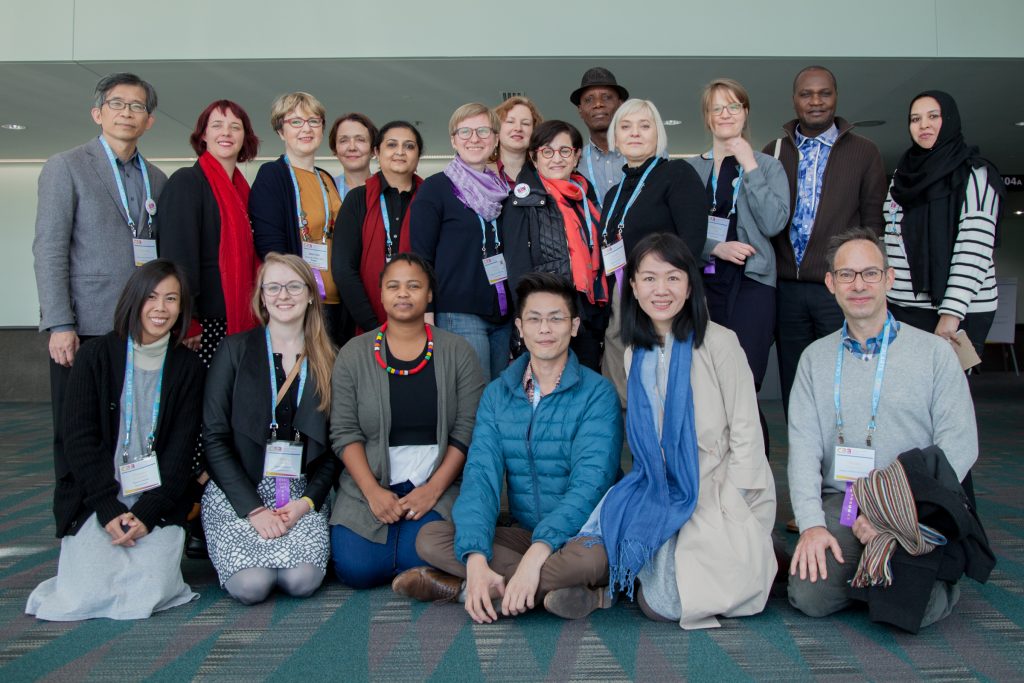
Now in its seventh year, the CAA-Getty International Program brought fifteen new participants and five alumni to the 2018 Annual Conference in Los Angeles. Click here to read their bios and learn more. Photo: Rafael Cardenas
PROGRAM
Global Conversations 2018
Preconference Colloquium
Tuesday, February 20, 2018
The Getty Center
8:30 AM Coffee, welcome, and introductions
9:15 AM Postcolonial and Eurocentric Legacies
Chair: Peju Layiwola, Artist and Professor of Art History, Department of Creative Arts, University of Lagos, Nigeria
Beyond the Readymade: The Use of Found Objects in Contemporary South African Art
Alison Kearney, Lecturer, University of the Witwatersrand (Wits), Johannesburg, South Africa
Resistance to Western Paradigms in East European and Latin American art from the late 1960s to 1989
Katarzyna Cytlak, Postdoctoral Researcher, Universidad Nacional de San Martín, Buenos Aires, Argentina
The Emergence of Taiwan’s Modern Visual Art and the Formation of Identity
Hsin-tien Liao, Dean of College of the Humanities, National Taiwan University of the Arts, Taipei, Taiwan
10:15 AM Global Trends in Museum Research and Exhibitions
Chair: Ildiko Feher, Associate Professor, Department of Art History, Hungarian University of Fine Arts, Budapest, Hungary
Digital Media Exhibition Curating in a University: the Case of the University of Port Harcourt Museum
John Agberia, Professor, University of Port Harcourt, Nigeria
Thinking Cross-culturally: Asian Art in a Visual Dialogue,
Markéta Hánová, Director of the Collection of Asian Art, National Gallery, Prague, Czech Republic
Gender Issues in Museums: Possibility, Provocation, Necessity?
Natalia Keller, Researcher of the Collection, Museo Nacional de Bellas Artes, Santiago, Chile
11:15 AM Interdisciplinary and Transnational Methodologies
Chair: Nomusa Makhubu, Senior Lecturer of Art History, Michaelis School of Fine Art, University of Cape Town, South Africa
Mirrors and the Invention of Perspective
Felipe Chaimovich, Chief Curator and Professor, Museo de Arte Moderna de São Paulo and Fundação Armando Álvares Penteado, Brazil
Experiments and Innovative Strategies in Croatian Photography during the 1960s and 1970s
Sandra Krizic-Roban, Senior Research Advisor, Institute of Art History, Zagreb, Croatia
Understanding African Art: an Interdisciplinary Exercise
Romuald Tchibozo, Senior Lecturer, University of Abomey-Calavi, Benin
12:15 PM Lunch
2:00 PM Cultural Identity, Politics, and the Powers of Art
Chair: Parul Pandya Dhar, Associate Professor of South and Southeast Asian Art History, Department of History, University of Delhi, India
Tracing the Cultural Ideology of the Indus Valley People
Sarah Umer, PhD Coordinator/Assistant Professor, Lahore College for Women, Pakistan
Datok Fatimah in Chinese Body: The Homely and Unhomely Presence of a Klang House Temple
Simon Soon, Senior Lecturer, Visual Art Department, University of Malaya, Kuala Lumpur, Malaysia
Reenergized by the Maidan: A Conjunction of Art and Politics
Natalia Moussienko, Leading Research Fellow, Modern Art Research Institute, National Academy of Arts, Kyiv, Ukraine
3:00 PM Considering an International Art History Curriculum
Chair: Cezar Bartholomeu, Artist and Professor of Art History, School of Fine Arts, Universidade Federal do Rio de Janeiro, Brazil
Terminology and Methodology in Teaching Asian Art to Russian Art History Students
Anna Guseva, Associate Professor, Higher School of Economics, St. Petersburg, Russia
A Chinese Perspective on Cross-cultural Transmissions of Art History
Chen Liu, Associate Professor, Tsinghua University, Beijing, China
Translation and Change: Teaching Art History in Thailand
Thanavi Chotpradit, Silpakorn University, Bangkok, Thailand
4:00 PM Open discussion
Moderator: Steven Nelson, Professor of African and African American Art and Director of the UCLA Center for African Studies
5:00-6:30 PM Cocktail Reception
News from the Art and Academic Worlds
posted by CAA — May 23, 2018
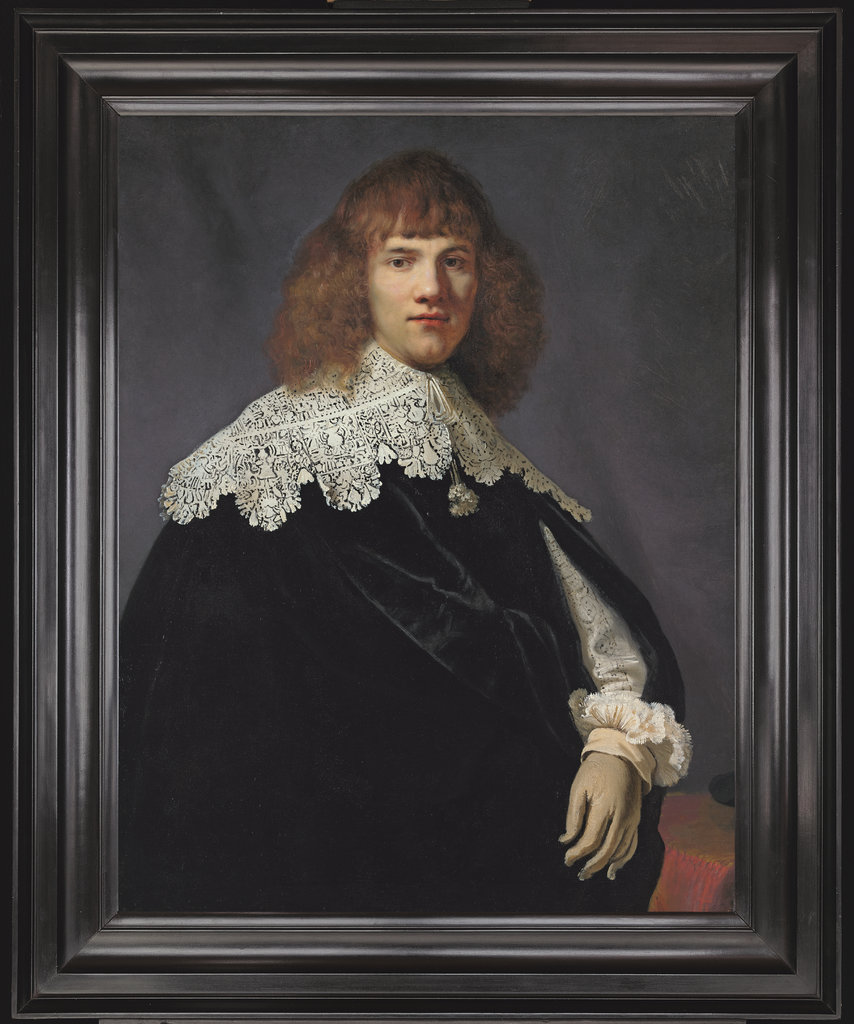
The Dutch art dealer Jan Six says that Portrait of a Young Gentleman is by Rembrandt, and several high-profile experts agree. Credit: René van Gerritsen/Jan Six Fine Arts, via NYT
A New Rembrandt? A Dutch Art Dealer Says He’s Found One
Portrait of a Young Gentleman would be the first wholly unknown Rembrandt painting to be attributed in 44 years. (New York Times)
Opinion: Let’s End Commencement
Clemon University professor Jonathan Beecher Field shares his view on why the mass commencement ceremony is a ritual that should be replaced. (Inside Higher Ed)
How Do You Conserve Time-Based Media? Museums Invest in Research to Keep Up with New Technologies
Time-based media art conservation is seeing a surge in interest in funding and formalization. (The Art Newspaper)
The Vatican in Venice (And a Cardinal Who Walks on the Wild Side)
The Catholic Church’s debut pavilion at the Venice Architecture Biennale will consist of 10 full-scale chapels built on an island in the Venice lagoon. (The Guardian)
Naima J. Keith and Diana Nawi to Curate Prospect.5 in New Orleans
The city’s contemporary arts triennial is slated to open in the fall of 2020. (Artforum)
Is It Even Possible to Comprehend a Work of Art Without Seeing a Woman Next to It (for Scale)?
Ben Davis & Julia Halperin examine an enduring and strange stock photo phenomenon. (artnet News)
Affiliated Society News for May 2018
posted by CAA — May 22, 2018
Affiliated Society News shares the new and exciting things CAA’s affiliated organizations are working on including activities, awards, publications, conferences, and exhibitions. For more information on Affiliated Societies, click here.
International Sculpture Center (ISC)
ISC is offering new graduates the professional resources they need to launch their careers – Student/Young professional membership – at discounted rate of $45. For more info, visit https://www.sculpture.org/documents/aboutisc/specialoffers.shtml
ISC is now accepting applications for our Fall/Winter residency @ Mana Contemporary. Apply today https://www.sculpture.org/residency/mana-update.shtml
Registration opens in June for the 28th ISC Conference: Defining Moments in the Face of Change and is available to ISC members, non-members, students, and all those with an interest in sculpture. Come join us in Philadelphia for engaging panel discussions, networking events, and exciting tours & optional activities. https://sculpture.org/philly2018/
Association of Art Museum Curators (AAMC)
The Association of Art Museum Curators and AAMC Foundation is honored to present a series of three webinars on research, advances, and issues surrounding the topic of provenance. With the establishment of substantial research databases and resources, great progress has been made in researching artworks that may have been subject to unlawful appropriation during the World War II era. As museums work to make their collections accessible online, there is both the need and potential to extend these advances to other categories of objects. The first webinar will acknowledge the impact of the pioneering work in WWII era research and provide updates on the current status within the field. The second session will offer a review of work currently being undertaken for non-WWII era looting and specifically looking at fields, including but not limited to, African Art, Asian Art and Antiquities. In the final session, we will emphasize the interest and need for progress in collaboration across diverse fields, present information on sharing data, and digitization and resources in communicating knowledge. The three webinars will build from seminar to seminar, but do not require attendance at each one to gain value from an individual session. Scheduled over three Tuesdays this June 2018, registration is available at a purchase of a single session or package of all three. Members and non-members alike can register directly online, with group rate packages available to participate. Access to webinar recordings will also be available for viewing with purchase. The first webinar on June 12 is Advances in WWII Era Research; the second on June 19 is Going Beyond WWII Era Research; and the third on June 26 is Sharing Research, Asking New Questions. Register to participate today.
Association of Print Scholars (APS)
The Association of Print Scholars hosted its third annual Distinguished Lecture at the CUNY Graduate Center on January 26, 2018. The curator Rémi Mathis, of the Bibliotheque Nationale de France, delivered the lecture titled “A Means to an End: The Process of Understanding French Prints.”
During the CAA conference in Los Angeles, many members joined us for our affiliated society panel, “Now you see it, now you don’t: Materialism and Ephemeral Prints,” chaired by Dr. Yasmin Railton of Sotheby’s Institute of Art. We also hosted a member’s reception at the East Los Angeles based workshop Self Help Graphics and toured their exhibition on Día de los Muertos.
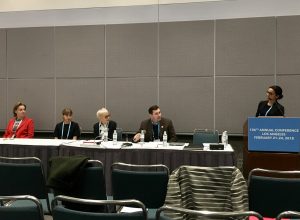
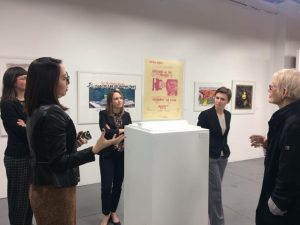
APS is pleased to announce our 2019 CAA panel “Printing Color: Reproducing Race Through Material, Process, and Language,” chaired by Christina Michelon. Michelon is a Luce /ACLS Fellow in American Art and a PhD Candidate in Art History at the University of Minnesota-Twin Cities where she is completing her dissertation “Interior Impressions: Printed Material in the Nineteenth-Century American Home.” Her work has been supported by the Smithsonian Institution, the Winterthur Museum & Library, the Center for Craft, Creativity, and Design, the American Antiquarian Society, and the Chipstone Foundation. “Printing Color: Reproducing Race Through Material, Process, and Language” seeks to investigate the racialized dimensions of print and printmaking. The medium has played a central role in the ideological founding of “race” and its hierarchies through visual representation. However, print’s materials, processes, and the language we use to describe them interface with conceptions of race in ways that require further study. Please be on the lookout for our upcoming CFP.
Society of Historians of Eastern European, Eurasian, and Russian Art and Architecture (SHERA)
The Board of the Society of Historians of Eastern European, Eurasian, and Russian Art and Architecture (SHERA) is pleased to announce the SHERA-sponsored panel for the 50th Annual ASEEES Convention in Boston, MA, December 2018. Dr. Hanna Chuchvaha’s panel “The Passion for Collecting: Collectors and Their Collections in Imperial Russia, 1800-1917” will include papers on Zinaida Volkonskaia’s Allée de Souvenirs (Laura Schlosberg), Print Collections of Female Crafts in Late Imperial Russia (Hanna Chuchvaha), Reform and Rehang in the Tretyakov Gallery, 1913-1917 (Isabel Stokholm) and will be of interest not only to art historians but also to scholars of museology, women’s studies, and visual culture.
Association for Modern and Contemporary Art of the Arab World, Iran, and Turkey (AMCA)
Book Launch Events: “Modern Art in the Arab World: Primary Documents” (April 28 Beirut and May 23 New York)
AMCA is pleased to announce launch events in Beirut (Sursock Museum) on April 28 and in New York (MoMA) on May 23 to celebrate the publication of Modern Art in the Arab World: Primary Documents (2018), edited by Anneka Lenssen, Sarah Rogers, and Nada Shabout. Both events bring to life Modern Art in the Arab World: Primary Documents and the book’s diverse content, multiple collaborators, and rich source materials that aim to further the study of modernism in a global frame.
This anthology offers an unprecedented resource for the study of modernism: a compendium of critical art writings by 20th-century Arab intellectuals and artists. The selection of texts—many of which appear for the first time in English—includes manifestos, essays, transcripts of roundtable discussions, diary entries, exhibition guest-book comments, and letters. Traversing empires and nation-states, diasporas and speculative cultural and political federations, the documents bring to light the formation of a global modernism that includes debates on originality, public space, spiritualism and art, postcolonial exhibition politics, and Arab nationalism. The sourcebook is framed chronologically, and features contextualizing commentaries and essays to assist readers in navigating its broad geographic and historical scope. A newly commissioned essay by Ussama Makdisi provides a historical overview of the region’s intertwined political and cultural developments during the 20th century.
Speakers included:
Zeina Arida, director of the Nicolas Ibrahim Sursock Museum in Beirut
Iftikhar Dadi, associate professor in the Department of The History of Art and Visual Studies at Cornell University
Anneka Lenssen, assistant professor of Global Modern Art in the History of Art Department at the University of California, Berkeley.
Glenn D. Lowry, director of The Museum of Modern Art in New York.
Sarah Rogers, independent scholar.
Nada Shabout, professor of art history in the College of Visual Arts and Design and the coordinator of the
Contemporary Arab and Muslim Cultural Studies Initiative at the University of North Texas.
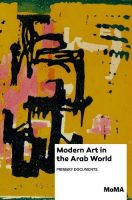
Explore source documents for Modern Art in the Arab World
AMCA has made a number of primary documents in Arabic and French available online. Click here to explore.
The Feminist Art Project (TFAP)
Call For Papers
The Feminist Art Project’s Day of Panels will be co chaired by Christen Clifford and Jasmine Wahi. The Day of Panels will be held at the Hilton in NYC at CAA on Feb 16th, 2019. The 2019 symposium will focus on rape and representation. The co-chairs are looking for papers, video and art that dwell in the sexual wounds of rape and sexual assault and look for the light of sexual justice. We seek a wide array of proposals on possible topics such as rape and representation, the meanings of sexual justice, gender and power in the art world, intersectional feminisms and responses to assault.
How has sexual assault affected feminist art practices? Who has power and why? What institutional changes need to happen to work towards sexual justice? Feminist art has long dealt with the oppressions and violations of colonialism, slavery, and couverture. TFAP 2019 is dedicated to the exploration of sex, power and justice through intersectional art and activism, academics and healing, and creating a shared space: bringing intellect and emotion together to demand bodily autonomy.
The day of panels will feature panels, video art, and a digital gallery.
Paper, panel and performance proposals should include a short (100 word) abstract /description of work, 100 word bio, and any relevant links. Header should read: TFAP 2019 Paper
Video and Image submissions should include links (and passwords, if appropriate) and up to 5 images. Please use email headers: TFAP 2019 Video or TFAP 2019 Image. All images should be labeled: LASTNAME_FIRSTNAME_TFAP.jpg
Please send proposals to
By June 14th.
Association of Academic Museums & Galleries (AAMG)
By popular demand, we’ve expanded the registration capacity for the AAMG Bootcamp Workshop. To add the workshop to your existing conference registration, please email membership@aamg-us.org
What: AAMG Bootcamp for Academic Museums
Where: Lowe Art Museum, University of Miami
When: Thursday, June 21, 9am – 3pm
with Jill Hartz and Barbara Rothermel Lowe Art Museum, University of Miami
Only open to AAMG and UMAC members; $100 (lunch and materials included)
This intensive professional development workshop covers key concepts and practices in academic museum management. Whether you’re a seasoned professional or new to the field, the workshop offers opportunities to learn about innovative and best practices and share challenges and achievements. We’ll cover mission and governance, advisory boards, strategic planning, our teaching role, working with faculty and students, community relations, and collections management and planning.
Instructors: Jill Hartz, Executive Director, Jordan Schnitzer Museum of Art, University of Oregon / President Emeritus, AAMG Barbara Rothermel, Director, Daura Gallery, Lynchburg College / Vice-Chair, UMAC
Association of Historians of American Art
Panorama: Journal of the Association of Historians of American Art has received an $8,500 grant from the Wyeth Foundation for American Art. A peer-reviewed, open-access online journal dedicated to American art and visual culture in all media, from the colonial period to the present day, Panorama welcomes submissions in various formats, including feature length articles (7,000-10,000 words), research notes (maximum of 2,500 words), book and exhibition reviews, and “Bully Pulpit” suggestions—texts that trace a conversation or debate on a topic that is of general interest to the field.
New Media Caucus (NMC)
The New Media Caucus (NMC) is pleased to announce the inaugural Advisory Board. Voted in by the Board of Directors, the members of the Advisory Board will assist with the core missions and the growth of the caucus. We welcome Hasan Elahi, internationally recognized media artist and Associate Professor of the University of Maryland; Sue Gollifer, pioneer of early computer art, Director of ISEA International and academic staff at the University of Brighton in the UK; and Guna Nadarajan, theorist, curator, and Dean and Professor at the Penny W. Stamps School of Art and Design at the University of Michigan. We look forward to working with, and learning from, our esteemed colleagues.
Society of Architectural Historians (SAH)
The Society of Architectural Historians has received a three-year, $120,000 grant from The Richard H. Driehaus Foundation for general operating support. The grant provides SAH with vital unrestricted income needed to fulfill its educational mission and support day-to-day operations.
The Society of Architectural Historians announced the 2018 recipients of the SAH Publication Awards and the SAH Award for Film and Video at its 71st Annual International Conference awards ceremony on April 20, at the Landmark Center in Saint Paul, Minnesota. The SAH Publication Awards honor excellence in architectural history, urban history, landscape history and historic preservation scholarship as well as architectural exhibition catalogues. The SAH Award for Film and Video is an annual award that was established in 2013 to recognize the most distinguished work of film or video on the history of the built environment. SAH will begin accepting nominations for the 2019 awards on June 1, 2018.
SAH is accepting applications for the 2018 SAH/Mellon Author Awards, designed to provide financial relief to scholars who are publishing their first monograph on the history of the built environment. The application deadline is May 31, 2018.
SAH is accepting abstracts for its 72nd Annual International Conference in Providence, Rhode Island, April 24–28. The submission deadline is 11:59 pm CDT on June 5, 2018. View the full call for papers at sah.org/2019.
International Association of Art Critics United States (AICA-USA)
AICA-USA‘s 2018 annual meeting was Saturday, May 19 at The Brooklyn Rail Headquarters at Industry City in Sunset Park, Brooklyn. The meeting coincided with a panel discussion featuring David Salle and Carroll Dunham.
AICA-USA board member Phong Bui says: “Ever since Susan Harris was the guest critic for the Rail’s November 2016 issue, which featured a luminous selection of our writer colleagues who are AICA members and board members, we have kept the collaboration alive with many AICA writers contributing regularly to our Art Seen reviews, such as Barbara and Alfred MacAdam, Lilly Wei, Eleanor Heartney, Amei Wallach, and Susan herself as an ongoing effort to keep the collaboration alive.
On the occasion of our forthcoming event featuring David Salle and Carroll Dunham on their respective publications, How to See and The Collected Writings of Carroll Dunham, I thought it would be a timely occasion to create a panel discussion coinciding with Industry City’s Open Studios, which invites the local artist community to participate.”
David Salle in Conversation with Carroll Dunham, moderated by Phong Bui
Panelists: Josephine Halvorson, Adam Pendleton, Martha Schwendener, and Amei Wallach
Rail HQ
253 36th Street, Suite C304
Industry City in Sunset Park
Saturday, May 19
Coffee and bagels: 10:30am
Conversation: 11am–12:30pm
AICA-USA Business Meeting: 12:30–1:00pm

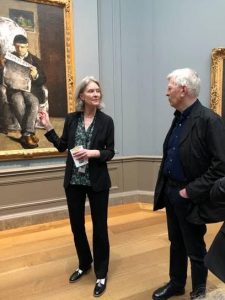

On May 8 and 9, 2018, AICA-USA members gathered in Washington D.C. for a two-day visit. 2017 AICA-USA Distinguished Critic Lecturer Paul Chaat Smith led members through his much-lauded exhibition, Americans, at the National Museum of the American Indian in Washington DC. AICA-USA member John Elderfield and his colleague Mary Morton led members through the exhibition Cézanne Portraits, which they co-curated at the National Gallery of Art.
The group also toured Lynn Cooke’s exhibition Outliers and American Vanguard Art at the National Gallery. AICA-USA was fortunate to have been granted ten VIP passes for entry to the National Museum of African American History and Culture, which members enjoyed without having to undergo the typical long wait time for entry passes.
Association for Textual Scholarship in Art History (ATSAH)
Recent member’s publications
Charles Burroughs, “Botticelli’s Stone: Giorgio Vasari, Telling Stories, and the Power of Matter.” Artibus et Historiae 76 (2017): 297–325.
Liana De Girolami Cheney, “Giorgio Vasari’s planetary ceiling: A Neoplatonic Voyage.” In Artistic Responses to Travel in the Western Tradition, ed. Sarah J. Lippert (London: Routledge Research in Art History, 2018): 158-169.
Karen Hope Goodchild, “Masaccio, Andrea del Sarto, Il Lasca, and the Sausage School of Florence.” Source. Volume 36, number 3/4 (Spring/Summer 2017): 178-187.
Sarah J. Lippert, ed. Artistic Responses to Travel in the Western Tradition
(London: Routledge Research in Art History, 2018).
ANNOUNCEMENT AWARDS for Students and Scholar
ASSOCIATION FOR TEXTUAL SCHOLARSHIP IN ART HISTORY
In commemoration of our 30th anniversary, ATSAH plans to offer two awards: one prize for the best article by an emerging scholar (no higher than Associate level). The topic may range from classical to Pre-Raphaelite art, reflecting the aims of ATSAH. The second is a small travel grant for junior scholar presenting a paper an ATSAH session. The board of ATSAH selects these awards.
For further data, contact:
Liana Cheney, PhD, President of ATSAH,
lianacheney@earthlink.net
SECAC
Lawrence Jenkens, 1st Vice-President and ex-officio chair of the SECAC Nominating Committee is pleased to announce the election of the following members to the SECAC Board of Directors for a three-year term of appointment that begins immediately: For Alabama, Wendy DesChene, Professor of Art, Auburn University; for Kentucky, Eileen Yanoviak, Director of the Carnegie Center for Art and History, New Albany, Indiana; for Louisiana: Jill R. Chancey, Assistant Professor of Art History, Nicholls State University, Thibodaux, Louisiana; for North Carolina: Kathryn Shields, Associate Academic Dean, Guilford College, Greensboro, North Carolina; and for the Third At-large Seat: Claire L. Kovacs, Director, Augustana Teaching Museum of Art, Augustana College, Rock Island, Illinois.
Community College Professors of Art and Art History (CCPAAH)
The Community College Professors of Art and Art History will have two opportunities to submit presentations for our panels next year. Please watch the news from CAA to submit a proposal for our session at next year’s conference in New York. We will also have an opportunity to submit for our panel at the FATE (Foundations in Art Theory and Education) Conference in Cincinnati next spring. Watch both of their websites for more information and the details for submissions. For more information contact Susan Altman, ccpaah@gmail.com
Foundations in Art: Theory and Education (FATE)
http://www.foundations-art.org/
FATE’s 17th Biennial Conference will be hosted by Columbus College of Art & Design in Columbus, Ohio on April 4th-6th, 2019. The call for sessions closed on May 18, but conference organizers will soon be seeking paper proposals for panel discussions and workshop events surrounding the conference theme, Foundations in Flux. http://www.foundations-art.org/conferences
Positive Space is FATE’s bi-monthly podcast providing opportunities for those passionate about art foundations to discuss and promote excellence in the development and teaching of college level foundations in art & design studio and history classes.
In Episode 30, of FATE’s Positive Space podcast we discuss creative detours, the mystery of art, becoming comfortable in your own skin, and the habit/repetition, and courage it takes to make things, with artist & educator, Gary Setzer, Associate Professor, Division Chair of the First Year Experience at the University of Arizona.
Episode 29 is a discussion about experimentation. Everyone talks about it, but practical examples of how to implement experimentation within our creative studios/classroom spaces are rarely deeply examined. Lily Kuonen, Associate Professor & Foundations Coordinator at Jacksonville University, discusses her artwork which she describes as PLAYNTINGS (play + paintings) and how the element of playful experimentation has become a crucial aspect of her teaching pedagogy.
Episode 28 was recorded live at the FATE panel at the 106th Annual College Art Association Conference held in Los Angeles, moderated by Naomi Falk, the FATE CAA Representative.
If you have podcast ideas, contact us!
Positive Space has a phone number: 904-990-FATE. Give us a call & record a message today or visit: http://www.foundations-art.org/positive-space-podcast
Membership: Starting the 2018/2019 membership period, FATE has made changes to the Individual Membership fees including a new Adjunct Faculty Membership rate for part-time and contingent faculty members: http://www.foundations-art.org/membership
News from the Art and Academic Worlds
posted by CAA — Apr 25, 2018
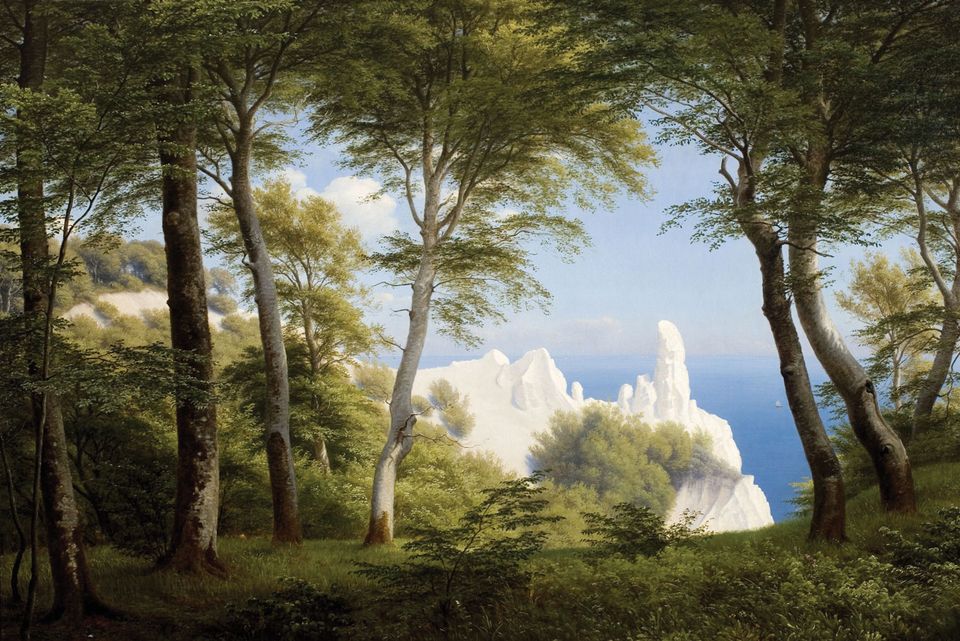
P.C. Skovgaard’s View of the Harbour from Mons Klint, 1850, Skovgaard: Skovgaard Museet, via The Art Newspaper.
The Way You See Color Depends on What Language You Speak
It’s less about seeing what is there and more about how the brain interprets. (The Conversation)
Art Institute Lands Largest Announced Cash Donation, $70 Million in Total
The museum’s long-range plan has included hopes to put up a new building, possibly devoted to Asian art. (Chicago Tribune)
Are Undergraduate Degrees in Curating Useful?
Is curating something that can, or should, be taught to undergraduate students? (Apollo Magazine)
Romanticism Show Surveys Landscapes of Northern Europe
The first major exhibition of its kind includes Turner and Friedrich as well as less familiar Romantics. (The Art Newspaper)
It Matters a Lot Who Teaches Introductory Courses. Here’s Why.
A new paper combines administrative data from six community colleges with a detailed faculty survey. (Chronicle of Higher Education)
Frida Kahlo Barbie Doll Banned from Shop Shelves in Mexico
A court has barred sales in Mexico of the doll, ruling that members of her family own the sole rights to her image. (BBC)
Affiliated Society News for April 2018
posted by CAA — Apr 17, 2018
Affiliated Society News shares the new and exciting things CAA’s affiliated organizations are working on including activities, awards, publications, conferences, and exhibitions. For more information on Affiliated Societies, click here.
Society of Historians of Eastern European, Eurasian, and Russian Art and Architecture (SHERA)
Society of Historians of Eastern European, Eurasian, and Russian Art and Architecture (SHERA) is an affiliate organization of CAA and ASEEES and partner organization of SAH; elected Board Officers are Eva Forgacs, President; Karen Kettering, Vice-President / President Elect; Alice Isabella Sullivan, Secretary / Treasurer; Yelena Kalinsky, Listserv Administrator; Corina L. Apostol, News Editor; and Anna P. Sokolina, SHERA-SAH Liaison. During recent elections, SHERA reelected Members-at-Large Hanna Chuchvaha, Nic Iljine, Natalia Kolodzei, and Andrey Shabanov.
Thanks to a generous donation from an anonymous donor, SHERA is offering annually two SHERA Graduate Student Travel Grants of 1,500 USD each. The grant is given for five consecutive years (2017-2021), to help defray travel costs for a graduate student – SHERA member, presenting a paper at the CAA Annual Conference or the ASEEES Annual Convention. Applications will be evaluated based on the academic merit of the paper topic and financial need. SHERA is especially committed to subsidizing a graduate student who is attending the conference for the first time or who has no local institutional resources for travel support. Calls for application will be posted to H-SHERA.
Association of Academic Museums & Galleries (AAMG)
AAMG’s next annual conference will be held June 21-24, 2018, at the Lowe Art Museum (University of Miami).
Our 2018 conference is a partnership with UMAC (University Museums and Collections), a committee of ICOM (International Council of Museums). We encourage members of either organization to join us and explore this year’s theme:
Audacious Ideas: University Museums and Collections as Change-Agents for a Better World
We live in a dangerous, often unstable, and environmentally compromised world. What can academic museums, galleries, and collections do to remedy this situation? If we are dedicated to teaching and training new generations of students, to serving increasingly diverse communities, how do we make a positive difference? How do we know we are making that difference? Let’s share great ideas and pressing concerns and learn and network with our global colleagues
Take a sneak peek at sessions, workshops, and more
Association for Latin American Art
ALAA would like to announce the formation of a new journal for scholars in our field:
Latin American and Latinx Visual Culture
Call for Submissions 2018
Latin American and Latinx Visual Culture
A new journal to be published by University of California Press
Latin American and Latinx Visual Culture (LALVC) is a new quarterly peer-reviewed academic journal published by the University California Press, scheduled for publication in January 2019. The editorial staff is now reviewing submissions.
Focused on Latin American and Latinx visual culture of all time periods — ancient, colonial, modern, and contemporary – LALVC publishes on Mexico, Central America, South America, the Caribbean, and the United States, as well as on communities in diaspora. LALVC considers all aspects of visual expression, including, but not limited to, art history, material culture, architecture, film and media, museum studies, pop culture, fashion, public art and activism. We welcome a range of interdisciplinary methodologies and perspectives. Additionally, the journal seeks to inspire and advance dialogue and debate concerning pedagogical, methodological, and historiographical issues.
We welcome scholarly research articles (10,000 to 12,000 words) written in English, Spanish, or Portuguese, as well as in American indigenous languages. Contact the editors if you are interested in proposing a guest-edited DIALOGUES section or writing a review of a book or exhibition.
To submit your work for review, or for any inquiries, please contact the editorial staff at LALVCsubmissions@ucpress.edu. Please review the journal’s author guidelines prior to submission.
Deadline for submissions to be considered for the first issue is June 1, 2018.
Association for Latin American Art
Fifth Triennial Conference
Chicago, March 8-9, 2019
CALL FOR PAPERS
The World Turned Upside Down:
Arts of Oppression and Resistance in the American Hemisphere
In keeping with these uneasy times, this Triennial welcomes studies of artworks and visual practices that either materialize powers of a presumed establishment or push back against its projected dominance, made or enacted anytime during more than 3000 years of Latin American history. An agent characterized as “radical” is often understood to challenge the fundamental nature of something, be it an established governance framework, broadly accepted social traditions, propagated religious strictures, or other oppressive cultural forces. This conference is interested in the fundamental role that art and architecture has played in both compounding constrictive powers and in giving shape to resistance, whether localized or widespread, subtle or indeed radical.
The committee therefore seeks proposals that offer specific answers to broad questions such as: How has art functioned to secure compliance, to encourage conformity, to intimidate, or to aestheticize state violence? Or in contrast, how do artistic practices demonstrate the will to resist, to protest, or to aggressively revolt? Case studies might use gender as a helpful index for exploring, for instance, visual culture that scaffolds patriarchal structures or works that deliver feminist challenges. Oppression and resistance could alternatively be viewed through the lens of form, perhaps with adherence to stylistic norms that affirm a particular worldview, or by way of notable artistic departures that seek to turn that world upside down. We encourage paper proposals that focus on overlooked and neglected artistic traditions, or offer new interpretations of canonical works of art. Submissions engaging methodologies drawn from decolonial, postcolonial, and critical race studies, as well as intersectional approaches to visual culture, among others, are also welcomed.
To be considered, participants must be members of the Association for Latin American Art. Please submit a CV as well as an abstract of approximately 500 words by Sept. 1, 2018 via e-mail to Delia Cosentino: dcosent1@depaul.edu
American Society for Aesthetics
The American Society for Aesthetics is pleased to announce meetings and conferences in the coming months. Non-members are welcome to attend:
- Conference: The Philosophy of Portraits, Co-sponsored with the University of Maryland, College Park, April 12-14, 2018. At the National Portrait Gallery and the University of Maryland. For on-line registration, complete schedule and list of speakers: http://aesthetics-online.org/events/EventDetails.aspx?id=941280
- ASA Eastern Meeting, Courtyard Marriott, Philadelphia, April 20-21, 2018. For on-line registration and program: http://aesthetics-online.org/events/EventDetails.aspx?id=969935&group=
- ASA Rocky Mountain Division Meeting, Drury Plaza Hotel, Santa Fe, NM, July 6-8, 2018. For on-line registration and program: http://aesthetics-online.org/events/EventDetails.aspx?id=708042&group=
- For the complete list of future ASA conferences and meetings, go to the ASA web site http://aesthetics-online.org, look near the bottom for MEETINGS and click “more”
Association of Art Museum Curators
The Association of Art Museum Curators (AAMC) and AAMC Foundation is honored to present a series of three webinars on research, advances, and issues surrounding the topic of provenance. With the establishment of substantial research databases and resources, great progress has been made in researching artworks that may have been subject to unlawful appropriation during the World War II era. As museums work to make their collections accessible online, there is both the need and potential to extend these advances to other categories of objects. The first webinar will acknowledge the impact of the pioneering work in WWII era research and provide updates on the current status within the field. The second session will offer a review of work currently being undertaken for non-WWII era looting and specifically looking at fields, including but not limited to, African Art, Asian Art and Antiquities. In the final session, we will emphasize the interest and need for progress in collaboration across diverse fields, present information on sharing data, and digitization and resources in communicating knowledge. The three webinars will build from seminar to seminar, but do not require attendance at each one to gain value from an individual session. Scheduled over three Tuesdays this June 2018, registration is available at a purchase of a single session or package of all three. Members and non-members alike can register directly online, with group rate packages available to participate. Access to webinar recordings will also be available for viewing with purchase.The first webinar on June 12 is Advances in WWII Era Research; the second on June 19 is Going Beyond WWII Era Research, June 19, 2018; and the third on June 26 is Sharing Research, Asking New Questions. Register to participate today.
Association of Historians of Nineteenth-Century Art (AHNCA)
The Fifteenth Annual Graduate Student Symposium in the History of Nineteenth-Century Art, co-sponsored by the Association of Historians of Nineteenth-Century Art (AHNCA) and the Dahesh Museum of Art, was held on March 18, 2018, in New York City. Ten doctoral students and candidates from the United States and Europe participated in the symposium, with an excellent array of papers covering a variety of international topics in different media. The Dahesh Museum of Art Prize was presented to Jennifer Pride, Florida State University, for her paper entitled “The Poetics of Demolition: The Pickax and Spectator Motifs in Second Empire Paris.” This prize of $1,000 was generously provided by the Mervat Zahid Cultural Foundation, and also includes with it the opportunity for publication in Nineteenth-Century Art Worldwide.
Historians of Eighteenth-Century Art and Architecture (HECAA)
The Historians of Eighteenth-Century Art and Architecture (HECAA) met in Orlando in late March and awarded Kee IL Choi the Dora Wiebenson prize for his conference paper, “In all things must the ancients be imitated: vases and diplomacy at the Qing court.” We are preparing for our first-ever standalone conference to commemorate the 25th anniversary of the founding of HECAA, Art and Architecture in the Long Eighteenth Century: HECAA at 25, in Dallas Nov. 1-4, 2018. For a complete program, see the conference website at: https://www.smu.edu/Meadows/AreasOfStudy/ArtHistory/Conferences. Our excellent blog, Enfilade, contains news of exhibitions, lectures, and new books in 18th-century art history from around the world; follow it at: enfilade18thc.com.
New Media Caucus
MFA student, America Salomon published a report of her experience at the 2018 CAA Conference on the New Media Caucus’ Hub, a blog-based publishing platform. America was the recipient of the New Media Caucus’s first Judson-Morrissey Excellence in New Media Award, a scholarship awarding $1,100 for a student of color working in the field of new media art to attend the CAA Conference.
Association of Research Institutes in Art History (ARIAH)
ARIAH, a consortium of 27 institutes of advanced research in art history, has elected a new slate of officers to serve three-year terms. They include Martina Droth, Chair, Yale Center for British Art; Amelia Goerlitz, Vice-Chair, Smithsonian American Art Museum; Nan Wolverton, Secretary, American Antiquarian Society; and Cynthia Roman, Treasurer, The Lewis Walpole Library. ARIAH operates several cooperative programs in support of research and scholarly exchange in art history. The Association’s 2017 Digital Development Award for Art History Publishing was presented to Afterall and Journal 18 in support of three projects that will take advantage of new possibilities offered by digital publishing platforms for presenting art historical research. The ARIAH East Asia Fellowship Program, now in its third year, has brought eight scholars from East Asia to ARIAH member institutes for three- to four-month residencies to conduct independent research. The program is supported by The Andrew W. Mellon Foundation, The Getty Foundation, and the Terra Foundation for American Art. ARIAH is grateful to the Kress Foundation for sponsoring an exchange program in 2017 that supported an interchange of expertise between professional staff of ARIAH member institutions and institutions belonging to the International Association of Research Institutes in the History of Art (RIHA). Recipients included a staff member from the Yale Center for British Art (ARIAH member) who traveled to the Courtauld Institute (RIHA member), and a staff member from the Swiss Institute for Art Research at the University of Zürich (RIHA member) who worked at the Getty Research Institute (an ARIAH member). ARIAH held its spring business meeting at the Getty Research Institute in conjunction with the 2018 CAA meeting in Los Angeles, and also sponsored a session entitled “Material Culture and Art History: A State of the Field(s) Panel Discussion,” that was chaired by Catharine Dann Roeber of the Winterthur Museum. ARIAH’s sponsored session at the 2019 CAA meeting will consider the place of artists’ residencies at the art history research institute.
Historians of British Art
On February 22, the Historians of British Art (HBA) held a CAA session entitled “The Image of the American Indian in Nineteenth-Century Britain: New Critical Perspectives.” This session, which was chaired by Michael Hatt (Warwick University) and Martina Droth (Yale Center for British Art), explored the various ways in which native peoples from the United States and Canada and the artifacts of their cultures were represented, portrayed, studied, and collected in Britain in the long nineteenth century. We thank the chairs and the speakers for sharing their research:
- Scott Manning Stevens (Syracuse University), “Resisting the Declension Narrative: The Image of the Iroquois in the Victorian Age”
- Dominic Hardy (Université du Québec à Montréal), “British Satirical Reception of North American Indigenous Performers and Their Work in the 1840s: Methodological Perspectives”
- Emily L. Voelker (Crystal Bridges Museum of American Art), “William Blackmore and Transatlantic Networks of Creation and Dissemination in William Henry Jackson’s Photographs of North American Indians (1877)”
HBA members also visited the Los Angeles County Museum of Art’s Study Center for Photographs and Works on Paper, where curators led a viewing and discussion of highlights from the museum’s collection of British photographs, works on paper, and decorative arts. Finally, at HBA’s annual business meeting, Martina Droth and Sarah Turner of British Art Studies led a discussion on the challenges and opportunities in publishing on British art in the era of transnational, digital, and global art history. Reflecting on the first three years of British Art Studies, forthcoming issues of the online periodical, and directions for the future, the speakers addressed innovations in digital publishing, the importance of Empire histories, and the definition of “British Art” in the current moment.
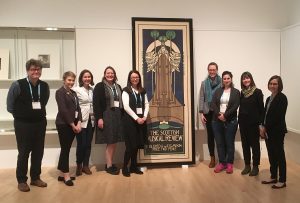
HBA Members attending CAA Study Session at LACMA, February 22, 2018. Photograph courtesy Courtney Long.
Association of Research Institutes in Art History (ARIAH)
ARIAH, a consortium of 27 institutes of advanced research in art history, has elected a new slate of officers to serve three-year terms. They include Martina Droth, Chair, Yale Center for British Art; Amelia Goerlitz, Vice-Chair, Smithsonian American Art Museum; Nan Wolverton, Secretary, American Antiquarian Society; and Cynthia Roman, Treasurer, The Lewis Walpole Library. ARIAH operates several cooperative programs in support of research and scholarly exchange in art history. The Association’s 2017 Digital Development Award for Art History Publishing was presented to Afterall and Journal 18 in support of three projects that will take advantage of new possibilities offered by digital publishing platforms for presenting art historical research. The ARIAH East Asia Fellowship Program, now in its third year, has brought eight scholars from East Asia to ARIAH member institutes for three- to four-month residencies to conduct independent research. The program is supported by The Andrew W. Mellon Foundation, The Getty Foundation, and the Terra Foundation for American Art. The Samuel H Kress Foundation is supporting an exchange program for facilitating the sharing of expertise between professional staff of ARIAH member institutions and institutions belonging to the International Association of Research Institutes in the History of Art (RIHA). In 2017, recipients included a staff member from the Yale Center for British Art (ARIAH member) who traveled to the Courtauld Institute (RIHA member), and a staff member from the Swiss Institute for Art Research at the University of Zürich (RIHA member) who worked at the Getty Research Institute (ARIAH member). ARIAH held its spring business meeting at the Getty Research Institute in conjunction with the 2018 CAA meeting in Los Angeles, and also sponsored a session entitled “Material Culture and Art History: A State of the Field(s) Panel Discussion,” chaired by Catharine Dann Roeber of the Winterthur Museum. ARIAH’s sponsored session at the 2019 CAA meeting will consider the place of artists’ residencies at the art history research institute.
Community College Professors of Art and Art History (CCPAAH)
The Community College Professors of Art and Art History had a very successful session at this year’s CAA Conference in Los Angeles. Championing the Relevancy of Studio Art and Art History in the Twenty-First Century: Stories of Success and Advocacy was chaired by Walter Meyer, Santa Monica College and Susan Altman, Middlesex County College. Thank you to all of the attendees, and presenters including Brian Seymour, Community College of Philadelphia Broadening the Appeal: Partnering with Local Collections; Shelley Drake Hawks, Middlesex Community College Art Appreciation Through A Transcendental Lens; Kathleen Wentrack, CUNY Queensborough Community College (Art History and Interdisciplinary Learning: A Model for Twenty-First Century Pedagogy; Valerie Taylor, Pasadena City College and Lisa Boutin Vitela, Cerritos College Interdisciplinary Futures: Investigating Renaissance Techniques and Art History; Justine De Young, SUNY Fashion Institute of Technology Rethinking Student Research as Public Scholarship; and Gretchen Batcheller, Cynthia Coburn and Ty Pownall, Pepperdine University Thinking Outside the White Cube: Piloting A Mobile Art Gallery in Los Angeles. All of these were interesting and thought-provoking presentations. The prospectus for next year’s conference will be posted later this spring in the CAA news and on our Facebook page, Community College Professors of Art and Art History. We welcome you to join us at next year’s conference in New York for our business meeting project share and our session, as well as our session at the FATE Conference. Please consider submitting a proposal to present at these sessions. If you want to be more involved, or have questions, please email us at: ccpaah@gmail.com
American Institute for Conservation of Historic and Artistic Works (AIC)
The most recent edition of the Journal of the American Institute for Conservation (JAIC), Vol. 56, No. 3-4, includes a variety of topics of interest to preservation professionals of all specialties, including the visual arts. The articles discuss subjects including the use of EEM Fluorescence Spectroscopy to describe natural organic colorants, the examination and analysis of Dunhuang and Turfan manuscript materials, documentation of objects using infrared and 3D imaging, and the development and testing of Incralac lacquer. Our 2018 special issue will delve into the use of reflectance hyperspectral imaging for the documentation and conservation of 2D artworks.
AIC is a membership organization supporting conservation professionals in preserving cultural heritage in different areas: architecture, book & paper, collection care, electronic media, health and safety issues, objects, paintings, photographic materials, textiles, and wooden artifacts. We produce research and publications, create educational opportunities in the field, and stimulate knowledge exchange with allied professionals. Our latest publication is Platinum and Palladium Photographs: Technical History, Connoisseurship, and Preservation, now available in our store.
One way to achieve our goal of supporting our field is through our annual meeting, where we bring together about 1,300 national and international professionals who gather to share ideas and techniques, discuss furthering the field of conservation through new initiatives, and increasing diversity. Material Matters 2018 is the theme of this year’s meeting, to be hosted in Houston, TX, May 29 through June 2, 2018. Please check out our programming for more details.
FATE (Foundations in Art: Theory and Education) News: http://www.foundations-art.org/
We had a great turnout for our Inclusion and Empathy discussion, as well as our affiliate session “Let’s Dance, But Don’t Call Me Baby: Dialogue, Empathy, and Inclusion in the Classroom and Beyond” at February’s conference in LA. A recording of our discussion will be available soon on FATE’s Positive Space podcast: http://www.foundations-art.org/positive-space-podcast
In addition, recent podcasts include: Episode 27: [ 3.28.18 ] A very honest conversation with David Janssen Jr., MFA Candidate at The University of Idaho. We unpack the privilege of being an educator, millennial haters & the urgent need to avoid becoming lazy by staying passionate about all aspects of being an academic. As a current graduate student, David offers a uniquely fresh perspective about classroom dynamics, with a focus on self reflection and empathy. Episode 26: [ 3.14.18 ] Rethinking creativity & being truly open to opportunities – even if they are unfamiliar & across the globe – marks only the beginning of our thoughtful chat with artist & educator Chris Kienke, Chair of the Foundations Curriculum at the School of Art & Design at the University of Illinois at Urbana-Champaign. Chris outlines how his evolving artistic practice has been informed by places/spaces while teaching abroad in the middle east. In addition, we discuss the state of foundations, advise for emerging educators & the navigating the politics of higher education.
Membership: Starting the 2018/2019 membership period, FATE has made changes to the Individual Membership fees including a new Adjunct Faculty Membership rate for part-time and contingent faculty members: http://www.foundations-art.org/membership
Accepting Proposals for FATE 2019, Deadline: May 18: http://www.foundations-art.org/conferences
The upcoming FATE conference, “Foundations in Flux”, hosted by Columbus College of Art & Design, will be in Columbus, OH, April 4 – 9, 2019. We are seeking proposals for panel discussions and workshop events surrounding the conference theme Foundations in Flux. As foundational learning continues to shift and grow, we educators find ourselves reinventing curricular structures to suit the needs of our first year students. We’re in a state of constant flux as we tackle new methods of technique and concept-based learning styles. At the upcoming FATE Conference, let’s dig into the ways we are engaging this new generation of global citizens — and how we can do that better.
FATE is committed to being inclusive by encouraging participation from a diverse range of voices within underrepresented identities and communities. In addition, we encourage participation from a wide spectrum within the academic community (high school educators, adjuncts, graduate students, art historians, fine artists, designers, faculty representing rural institutions, community colleges, and those teaching advanced courses).
Submit your proposals for chairing a session panel, leading a workshop, or leading a roundtable discussion & CV to FATE2019@CCAD.EDU. Please limit your topic proposals and/or workshop description to 200 words maximum. This submission deadline is Friday, May 18th, 2018.
Design History Society
The Design History Society is committed to supporting the development of research in the field of design history. The Society offers a number of annual grants and wards spread throughout the year and aimed at supporting a variety of research activities, aims and outputs. Together the grants and awards are available to a mixture of members and non-members and have been conceived to encourage innovative and inclusive definitions of design history and its methods and approaches.
DHS Conference Bursary
The Design History Society has a bursary fund to assist DHS Student members whose papers have been accepted for presentation at our annual conference. The Society endeavours to provide bursaries for up to 15 DHS student members presenting at our Conference. Each bursary includes the concessionary rate conference fee, attendance at the gala dinner. Deadline:
More information can be found at: https://www.designhistorysociety.org/awards/student-awards/dhs-conference-bursary
Design Writing Prize
Guest judge for the 2018, Johanna Agerman Ross, Curator at the Victoria & Albert Museum, and founder/director of the quarterly design journal Disegno
In order to encourage, recognise, and support writing that engages audiences in critical and contemporary issues in design writing, the Design History Society initiated a new writing prize in 2017. Running for the second time in 2018, this prize is open to scholars, researchers, critics, practitioners and educators within and outside the Society who demonstrate a commitment to furthering the work of critical debate in design through writing. The aim of the Design Writing Prize, in addition to promoting and celebrating excellent new work, is to advocate writing as a necessary and creative practice for communicating ideas related to design. In this vein, entries that include a variety of modes such as essays, interviews, reviews or editorial commentary are welcome and can either be published works or in manuscript phase. Deadline: 16.00 GMT on 15 June 2018
More information can be found at: https://www.designhistorysociety.org/awards/design-writing-prize
Student Essay Prize
Submissions are invited for the Design History Society Essay Prize, established in 1997 in order to maintain high standards in design history in higher education. Two essay prizes are awarded annually; one to an undergraduate student and the other to a postgraduate (MA or PhD). Deadline: 16.00 GMT on 15 June 2018.
More information can be found at: https://www.designhistorysociety.org/awards/student-awards/essay-prize
Research Travel & Conference Grant
The Research Travel and Conference Grant is awarded by the DHS annually to assist those need to travel to conduct essential research for their design history scholarship or to present new research at key academic conferences. Deadline: 15th May
More information can be found at: https://www.designhistorysociety.org/awards/research-grants/travel-grant
Strategic Research Grant
The Strategic Research Grant expresses the Society’s work to lead the academic commitment to design history research. Founded in 2012 to encourage design history research in non-Western geographies and post-colonial perspectives, as of 2015 the Strategic Research Grant is an annual award. The Grant supports original and significant research in non-Western, post-colonial and other areas, themes and methods that have either been overlooked or underrepresented in the field but are important to its future development. Applicants must be engaged in research leading to a conference paper or published outcome such as a peer-review journal or other academic publication. Deadline: 15th November
More information can be found at: https://www.designhistorysociety.org/awards/research-grants/strategic-travel-award
Research Exhibition Grant
The Research Exhibition Grant is awarded by the DHS annually to assist those engaged in design history research that leads to an exhibition or display. The exhibition or display may be permanent or temporary, and take a physical and/or digital format. Deadline: 15th March
More information can be found at: https://www.designhistorysociety.org/awards/research-grants/exhibition-grant
Research Publication Grant
The Research Publication Grant is awarded by the DHS annually to assist those engaged in design history research with the publication of their research in research-based outputs such as peer-reviewed journal articles or books published by an academic press or museum institution. Deadline: 15th January
More information can be found at: https://www.designhistorysociety.org/awards/research-grants/publishing-grant-1
Student Travel Award
The Student Travel Award is awarded by the DHS annually to encourage and support research activity amongst students in the field of design history. The grant is open to all student members of the society. To be eligible to apply, applicants must be currently enrolled as undergraduate or postgraduate student at any institution and undertaking research in the field of design history of any geography and period.
The Student Travel Award may be used towards the costs incurred for research trips including travel to conferences, accommodation, travel and other research expenses (e.g. photocopying costs, library membership). Deadline: 15th January
More information can be found at: https://www.designhistorysociety.org/awards/student-awards/student-award
Day Symposium Grant
The DHS Day Symposium Grant assists DHS members convene a symposium to discuss and disseminate design history research. The Grant is part of the Society’s aim to promote and support scholarship in the field of design history and to play a role in shaping an inclusive and innovative field. The DHS Day Symposium Grant aims to support high quality, original research activity. No fixed deadline
More information can be found at: https://www.designhistorysociety.org/awards/day-symposium-grant
Outreach and Events Grant
he DHS Outreach Event Grant provides assistance for DHS members to convene a public event to promote design history beyond a traditional academic setting. This Grant is part of the Society’s aim to promote the field of design history and to play a role in shaping inclusive and innovative forums, support activities that offer new perspectives on how design history can engage diverse audiences and contribute to public discourse that reaches wider communities. No fixed deadline
More information can be found at: https://www.designhistorysociety.org/awards/dhs-outreach-and-events-grant
Association for Textual Scholarship (ATSAH)
Members’ Publications
Eliana Carrra, “Un proposito di identificazione per il Ritratto di giovane con libro di Agnolo Bronzino: Benedetto Bsini,” Annali di Critic d’Arte N. 1 (2017):89-115.
Deborah Cibelli, Review of The Early Modern Child in Art and History, edited by Matthew Knox Averette, The Sixteenth Century Journal, XLVII (2016):783-85.
Jennifer Bates Ehlert, “Hylas and the Matinee Girl: John William Waterhouse and the Female Gaze,” Athanor, Vol. 36 (June 2018): 69-76.
Sara N. James, “Wit and Humor in Ugolinodi Prete Ilario’s Life of the Virgin at Orvieto,” Source: Notes in the History of Art vol 36, no.3-4 (Spring/Summer2017):159-67.
Sara N. James, “Review of Tarnya Cooper, Aviva Bunstock, Maurice Howard, and Edward Town, eds. Paintingin Britain 1500-1630: Production, Influences, and Patronage. A British Academy Publication. Oxford, Oxford University Press, 2016, for the Sixteenth Century Journal, XLVIII/1 (Spring2017):249-51.
Robin O’Bryan, “Carnal Desire and Conflicted Sexual Identity in a ‘Dominican’ Chapel” In Images of Sex and Desire in Renaissance Thought and Modern Historiography ed. Angeliki Pollali and Berthold Hub (Routledge, 2017), 40-68.
Robin O’Bryan, “Michelangelo’s Sistine Dwarf”
Source: Notes in the History of Art 36, no. 2 (Winter 2017): 67-77.
Emilie Passignat, ‘’Manière’, ‘maniéré’, ‘maniériste’ : transferts et enjeux théoriques autour d’un terme clé du vocabulaire artistique », in Michèle-Caroline Heck (ed.), Lexicographie artistique : formes, usages et enjeux dans l’Europe moderne (Montpellier, PULM, 2018), 363-376, on-line, doi: 10.26530/OAPEN_644313 .
Emilie Passignat, “Manière”, in Michèle-Caroline Heck (ed.), Lexart. Les mots de la peinture (France, Allemagne, Angleterre, Pays-Bas, 1600-1750) (Montpellier, PULM, 2018), 333-339.
Emilie Passignat,“Maniéré”, in Michèle-Caroline Heck (ed.), Lexart. Les mots de la peinture (France, Allemagne, Angleterre, Pays-Bas, 1600-1750) (Montpellier, PULM, 2018), 340-343.
Liana De Girolami Cheney, “Camillo Camilli’s Imprese for the Academies,” Journal of Literature and Art, Vol. 8 No. 4 (April 2018):598-613
Liana De Girolami Cheney, “Jan Haicksz Steen’s Woman at Her Toilet: “Provocative Innuendos,” Journal of Literature and Art Studies Vol. 7, No. 10, (October 2017): 1-11, doi: 10.17265/2159-5836/2017.10.000
Liana De Girolami Cheney, “Giovanni Antonio Bazzi, Allegories of Love: Emblematic Ardor,” Cultural and Religious Studies, Vol. 5, No. 5, (May 2017): 1-37, doi: 10.17265/2328-2177/2017.05.000
Pacific Arts Association
The Pacific in Europe, Europe and the Pacific Linden-Museum Stuttgart | 26–28 April 2018
The annual PAA-E meeting entitled “The Pacific in Europe, Europe and the Pacific” will be held at the Linden-Museum Stuttgart, State Museum of Ethnology, from 26 until 28 April 2018 to coincide with the exhibition Hawai‘i – Royal Islands in the Pacific (14 October 2017 – 13 May 2018).
The Pacific Arts Association’s XIII International Symposium will be held in Brisbane 25-28 March 2019.
The Pacific Chapter has decided to create a pre-symposium opportunity to visit and learn about the arts of Vanuatu whilst they plan and refine their travel arrangements for next year.
As well as participating in panel discussions about key issues relating to the arts of the Pacific, the Vanuatu conference will be a chance to visit Port Vila, engage with kastom, meet local artists and cultural workers, and experience town and the contemporary arts scene.
In the meantime, if this piques your interest, please contact Karen Stevenson on ks-kf@xtra.co.nz so that she can get a sense of numbers as she and colleagues continue to plan for this.
Association of Historians of American Art
CALL FOR PAPERS
The Association of Historians of American Art Fifth Biennial Symposium
October 4-6, 2018
Minneapolis-St. Paul, Minnesota
AHAA invites proposals for presentations on any aspect of North American art, visual/material culture, and architectural history, broadly construed. We encourage a broad range of proposals, reflecting a diversity of both topics and methodological approaches. Please send: (1) a 250-word abstract, (2) a proposed title, (3) a clear indication of presentation format, and (4) a short c.v. of no more than two pages by Friday, April 13, 2018 to Robert Cozzolino, Jennifer Marshall, and Christina Michelon, AHAA Symposium co-chairs at: ahaa.twincities@gmail.com. Inquiries may also be directed to that email address. http://www.ahaaonline.org/page/2018SymposiumCFP
CALL FOR PAPERS
AHAA sponsored session at CAA
February 13-16, 2019
New York, NY
As an affiliated society of CAA, the Association of Historians of American Art (AHAA) sponsors a session at CAA’s Annual Conference. This year, AHAA is seeking proposals for a one-and-a-half-hour professional session addressing any of the following: new pedagogies, exhibitions, patronage, auctions, and publishing. Please submit a title and short description of the session, along with the proposer’s c.v. and a statement of expertise on the topic proposed to sessions@ahaaonline.org by April 13, 2018.
SECAC
SECAC awards two $5,000 prizes annually: The Artist’s Fellowship, awarded to an individual artist or to a group of artists working together on a specific project, and the William R. Levin Award for Research in the History of Art, an award of an annual total of $5,000 to one or more art historians who are members of the organization. The Artist’s Fellowship entries must be submitted by August 14, 2018; the Levin Award entries must be submitted by August 31, 2018. For more information see: http://www.secacart.org/artists-fellowship and http://www.secacart.org/research-in-art-history.
The 74th Annual SECAC Conference, hosted by the University of Alabama at Birmingham, will be held in Birmingham, Alabama, October 17 through 20, 2018. Events during the conference will include a keynote address by Andrew Freear, Director of Auburn University’s Rural Studio. Freear is a recent Loeb Fellow at Harvard University Graduate School of Design and has designed and built Rural Studio exhibits across the globe including at the Whitney Biennial, the Sao Paulo Biennal, the V&A in London, MoMA NYC, and most recently, the Milan Triennale and the Venice Biennale. A SECAC-only private reception to view the exhibition, Third Space/Shifting Conversations about Contemporary Art will be held at the Birmingham Museum of Art, and the annual SECAC Artist’s Fellowship and Juried [Members] Exhibitions will be on view at UAB’s Abroms-Engel Institute for the Visual Arts. Designed by the world-renowned architect, the late Randall Stout, AEIVA is a center for UAB and the Birmingham community to engage with contemporary art and artists. The 2018 Members Exhibition will be juried by Peter Baldaia, Head of Curatorial Affairs, Huntsville Museum of Art. For more information see: http://www.secacart.org/conference.
Juried Exhibition submission deadline, April 15, 2018: https://secac.secure-platform.com/a/solicitations/home/3
Call for Papers deadline, April 20, 2018: https://secac.secure-platform.com/a/solicitations/home/2
Arts Council of the African Studies Association (ACASA)
This activity report pertains to events held by the Arts Council of the African Studies Association during the 2018 CAA Annual Conference at UCLA.
ACASA held one sponsored panel during the CAA Annual Conference. Titled “Abstraction in Africa: Origins, Meaning, Function” it was organized by Kevin Tervala, a Ph.D. candidate at Harvard University. A session that solicited contributors, it eventually included the following presentations:
- “Abstraction, Extraction, and Transaction in the Carved Doors of Zanzibar”
Janet Purdy, The Pennsylvania State University - “Between Abstraction and Figuration: Corporeal Excess and Uncertainty in Nineteenth-Century Zulu Vessels”
Theresa Sims, University of Illinois at Urbana–Champaign - “Abstraction and Mobility in Northwestern Kenya ”
Kevin Tervala, Harvard University
In addition to the ACASA-sponsored panel, ACASA organized a special event at the Fowler Museum at UCLA in the form of an Open House. The museum offered coffee, tours, and conversations about the exhibitions on view to ACASA members and CAA annual meeting participants: the Fowler’s PST show, Axe Bahia: The Power of Art in an Afro-Brazilian Metropolis, and Bread, Butter, and Power: Paintings by Meleko Mokgosi. It was a great opportunity to visit the museum and mingle with colleagues.
Historians of German, Scandinavian, and Central European Art & Architecture (HGSCEA)
HGSCEA organized another successful set of events at CAA this year in Los Angeles.
The well-attended sponsored session was chaired by Allison Morehead, and examined critical race theory in Scandinavian, Central European, and German art. It comprised four papers: Rebecca Houze considered constructions of ethnicity and national identity in Hungarian design, Pat Berman examined the discourse of whiteness in Norwegian art, Bart Pushaw drew attention to several cases of the representation and repression of race in Scandinavian art, and Kristin Schroeder analyzed the depiction of race and gender in a painting by Christian Schad. HGSCEA was also well represented at the conference more generally. Members presented their research in other sessions, acted as chairs and commentators, and represented organizations and journals. The participation of two early-career scholars, Tomasz Grusiecki and Max Koss, was supported by HGSCEA Travel Stipends.
The annual reception, a catered Mexican dinner at a studio space near the convention center, was attended by about forty members. They saw old friends, made new acquaintances, and learned the results of the 2017 Emerging Scholars Prize. From a large pool of strong submissions, the Board named two articles published last year as the winners: Tomasz Grusiecki, “Foreign as Native: Baltic Amber in Florence,” and Kerry Greaves, “Thirteen Artists in a Tent: Danish Avant-garde Exhibition Practice during World War II.” Morgan Ng received an Honorable Mention for “Toward a Cultural Ecology of Architectural Glass in Early Modern Northern Europe.”
During the business meeting, the Board not only heard reports from the president, treasurer, and website manager, but also discussed the proposals it had received for next year’s session at CAA in New York. All were appealing, but the Board selected the one sent by Kerry Greaves, “Women Artists in Germany, Central Europe, and Scandinavia, 1880-1955.”
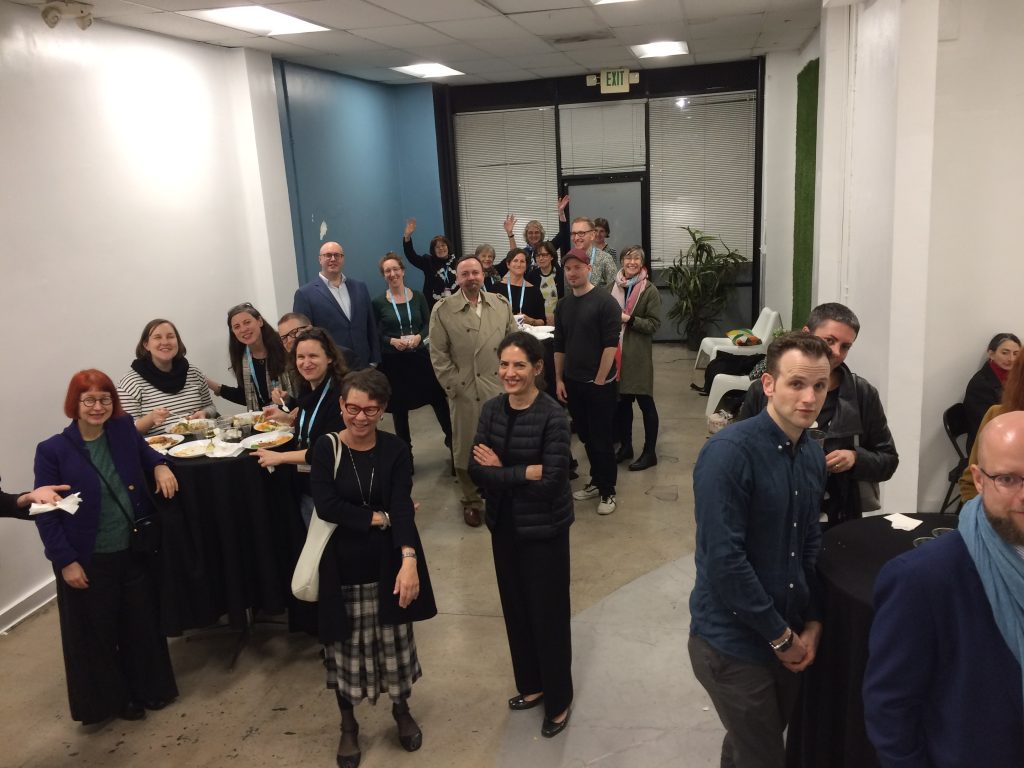
HGSCEA at the CAA Annual Conference in Los Angeles, 2018.
American Society of Hispanic Art Historical Studies (ASHAHS)
The American Society of Hispanic Art Historical Studies (ASHAHS) announced the results of the Eleanor Tufts Award at its business meeting at the 2018 annual conference of the College Art Association. The annual award, established in 1992 to honor Professor Tufts’ contributions to the study of Spanish art, recognizes an outstanding English-language book in the area of Spanish or Portuguese art history. This year the committee chose to give the Eleanor Tufts Award to Oscar E. Vázquez, The End Again: Degeneration and Visual Culture in Modern Spain (University Park, PA: Penn State University Press, 2017). In addition, the jurors selected two books for honorable mention: Ilona Katzew, et al., Painted in Mexico, 1700-1790: Pinxit Mexici (Los Angeles, CA: Los Angeles County Museum of Art; Mexico City: Fomento Cultural Banamex, A.C.; New York, NY: DelMonico Books/Prestel, 2017) and Amanda Wunder, Baroque Seville: Sacred Art in a Century of Crisis (University Park, PA: Penn State University Press, 2017).
Association of Historians of American Art (AHAA)
Preparations are underway for AHAA’s Fifth Biennial Symposium, October 4-6, 2018 in Minneapolis and St. Paul, Minnesota. The goal of this biennial symposium is to represent the most innovative, creative, and rigorous scholarship currently shaping the field of American art. http://www.ahaaonline.org/
The Executive Editors of Panorama: Journal of the Association of Historians of American Art are pleased to announce that The Henry Luce Foundation has awarded the journal a three-year, $45,000 grant to support publication of the journal. This grant supports the position of managing editor, provides professional development in art history and digital humanities, and funds subventions to help authors defray the cost of image reproduction fees.
“The Henry Luce Foundation has been a strong supporter of Panorama since its inception, and we are delighted to announce funding that ensures our financial base through 2020,” said Betsy Boone, an Executive Editor for the journal. “Luce funding has allowed us to professionalize our administrative structure, allowing us to bring cutting-edge scholarship on American art to audiences around the world through our open-access platform.”
The International Art Market Studies Association (TIAMSA)
TIAMSA is offering the following events over the upcoming months:
1) Porto Alegre, Brazil, April 8-10 – ART BEYOND ART: First Symposium on Art Systemic Relations (Goethe Institut, Porto Alegre) – From production to access, the world of visual arts have changed substantially in the last decades, especially considering the performances of agents and institutions which together act in the creation of legitimating structures and in the definition of what art is or is not. However, the logic of production, circulation, legitimization and consumption is also associated with spheres other than those specific to the art world, highlighting the connections inherent in the development of the greater art system. In this sense ART BEYOND ART, the first Symposium on Art Systemic Relations, proposes to debate the transformations in the mode(s) of operation and in the production of contemporary visual art. Essentially transdisciplinary, the event aims to open the dialogue between researchers of Arts, Sociology, Anthropology, Philosophy, Literature, Technology, Sciences and other areas. – This conference is an initiative of TIAMSA Art Market and Collecting – Portugal, Spain and Brazil (TIAMSA AMC_PSB). All further information can be found in the related post and on the Conference Website.
2) TIAMSA’s 2nd Conference will take place in September in Vienna: ART FOR THE PEOPLE? Questioning the Democratization of the Art Market.
2nd Conference
TIAMSA – The International Art Market Studies Association
Vienna, 27-29 September 2018
Apply by April 15, 2018
The art world and the market have traditionally been the domain of the elites and have thrived on exclusivity. However, the art world has arguably become much more democratic in recent years thanks to the digital revolution, the inclusion of emerging economies in the world art market system, and the vastly improved access to art and information. The price histories of works of art can nowadays easily be reconstructed using online databases; the threshold for art buying is significantly lowered by online sales platforms; and new buyers in emerging economies are making the art market much less Western-oriented. Moreover, an ever broader range of artworks in different price categories has put (fine) art within reach of the middle classes across the globe. At the same time, art institutions such as museums are under tremendous pressure to be less exclusive. Some of these democratizing tendencies are of course not new. For instance, publishing houses in Europe started disseminating prints on a massive scale already in the sixteenth century, thereby enabling larger segments of the population to acquire images. Read more here
TIAMSA members receive discounts to our events as well as Art Market Studies related publications from BRILL, Francis & Taylor, Brepols / Harvey Miller.
For more information go to https://www.artmarketstudies.org
Society of Architectural Historians (SAH)
The Society of Architectural Historians is now accepting abstracts for its 72nd Annual International Conference in Providence, Rhode Island, April 24–28. Please submit an abstract no later than 11:59 p.m. CDT on June 5, 2018, to one of the 34 thematic sessions, the Graduate Student Lightning Talks or the Open Sessions. SAH encourages submissions from architectural, landscape, and urban historians; museum curators; preservationists; independent scholars; architects; scholars in related fields; and members of SAH chapters and partner organizations. The thematic sessions have been selected to cover topics across all time periods and architectural styles. If your research topic is not a good fit for one of the thematic sessions, please submit your abstract to the Open Sessions. View the full Call for Papers at www.sah.org/2019.
SAH is now accepting applications for the 2018 SAH/Mellon Author Awards. Funded by a grant from The Andrew W. Mellon Foundation and administered by SAH, the award is designed to provide financial relief to scholars who are publishing their first monograph on the history of the built environment. The purpose of the award is to help defray the high costs of image licensing, reproductions and creation of original drawings and maps for monographs on the history of the built environment. The application deadline is May 31, 2018.
SAH has partnered with the Global Architectural History Teaching Collaborative (GAHTC) to offer Research-to-Teaching Grants and Field Seminar Travel Grants. These new grants are part of the GAHTC’s nearly $500,000 in funding to build new content for its free, digital platform of teaching materials. Learn more at gahtc.org/grants.
International Association for Word and Image Studies (Association Internationale pour l’étude des Rapports entre Texte et Image) (IAWIS/IAERTI)
Call for Participation for 2018 Conference of the International Society for Intermedial Studies
Intermedial Practice and Theory in Comparison
Hangzhou, China, 15-17 November 2018
With the ever-growing proliferation of electronic and other popular media in the more and more networked and “mediatised society,” the diversity and complexity of cultural reproduction and social reconstruction through media underscores now, more than ever, the need to expand Intermedia Studies by incorporating a “planetary” comparative perspective and encouraging voices from subaltern cultures. In recent years, Asian artists like CAI Guoqiang, the “Master of Gunpowder,” have gained international prominence in the intermedia world, and their intermedial practices were often executed and exhibited in various cultural epicentres, e.g., Beijing or New York. However active and interactive such practices are and however broad the audience is, a critical survey of the intermedia theory in cultural comparison is largely missing in previous discussions. We all use media and all media are related, but we might not view media in the same way. Therefore, this conference aims at fostering an interdisciplinary and intercultural conversation on intermedia between scholars, artists and theorists from all domains.
We are seeking panel, paper and round-table contributions that address the theme of the conference: revisiting intermedial practice and theory from a comparative perspective (e.g., past/present, East/West, etc.) to see how artistic, cultural and social practices differ from and interact with each other and how theories evolve in these media constellations locally and globally. We invite proposals for 10- or 20-minute presentations on a broad variety of topics and methodological approaches from disciplines including (but not limited to) Media Studies, Literary Studies, Cultural Studies, Critical Theory, Philosophy, Art History, Visual Arts, Musicology, Theatre and Performance Studies, Rhetoric, Gender and Sexuality Studies, Architecture and Design, Communication, Politics, Religious Studies, and Sociology.
Proposals for papers, pre-constituted panels, or round tables can be submitted by emailing the submission form (downloadable on http://wgyxy.hznu.edu.cn/ISIS2018) as an attachment to SFL@hznu.edu.cn with the subject line “Proposal ISIS2018”. Deadline for submissions is June 15, 2018, and acceptances will be notified by July 15,2018.
Please note that the working language of the conference is English.
Art Libraries Society of North America (ARLIS/NA)
- ARLIS/NA session at CAA in Los Angeles in February
Teams composed of art and design faculty and librarians presented their experiences collaborating with students in the library in a successful session on February 22nd entitled “Engaging the iterative: pedagogical experiments across art and design disciplines.” Chaired by Jennifer Martinez Wormser of the Laguna College of Art + Design; Emilee Mathews, form the University of California, Irvine, the individual presentations included:
COLORientation: Visualizing Color Systems
Xun Chi, Laguna College of Art + Design; Jennifer Martinez Wormser , Laguna College of Art + Design
The Intersection of Influence: Co-teaching the Undergraduate and Graduate Architecture Degree Project and Thesis Preparation Courses
Cathryn Copper, Woodbury University School of Architecture
Engaging the Art World in the Classroom
Bridget R. Cooks, University of California, Irvine; Emilee Mathews, University of California, Irvine
Collaborating, Learning, and Exhibiting
Parme Giuntini, Otis College of Art and Design; Kerri Steinberg, Otis College of Art and Design; Sue Maberry, Otis College of Art and Design
- Awards announced at ARLIS/NA annual conference in New York in February:
The Art Libraries Society of North America (ARLIS/NA) is pleased to announce Kathryn Wayne as the recipient of the 2017 Distinguished Service Award. She is the 27th person to receive the Society’s highest honor. The Distinguished Service Award honors an individual whose exemplary service in art librarianship, visual resources curatorship, or a related field has made an outstanding national or international contribution to art information. Kathryn’s deep and far-reaching contributions to the Society and to the field of art librarianship perfectly embody the accomplishments most valued by the Society.
Kathryn recently retired as head of the Art History/Classics Library at the University of California, Berkeley. She came to UC Berkeley in 1990 as Architecture and Landscape Architecture Librarian at Berkeley’s Environmental Design Library following many years as Architecture Librarian at the University of Arizona.
Two of her notable publications are the seminal reference book Architecture Sourcebook: A Guide to Resources on the Practice of Architecture published by Omnigraphics in 1997, and her contribution to the 33-volume Encyclopedia of Library and Information Sciences published by CRC Press in 2010, for which she wrote the chapter on Art Librarianship.
Despite these impressive professional accomplishments, Kathryn never lost sight of the fundamental role of librarianship at her home institutions. Her dedication to students endured throughout her career. She established an information literacy program at the University of California, Berkeley School of Environmental Design and shared her experience through a subsequent professional presentation on the program. She mentored San Jose State library school students and University of California undergraduate students. One former student wrote, “Kathryn has not only enriched the profession, she has shaped my life.”
The Art Libraries Society of North America (ARLIS/NA) is pleased to announce that the exhibition catalogue for Radical Women: Latin
American Art, 19601985 curated by Cecilia Fajardo Hill and Andrea Giunta, has been awarded the 39th annual George Wittenborn Memorial
Book Award, announced at the ARLIS/NA annual conference in New York in February.
The Art Libraries Society of North America (ARLIS/NA) is pleased to announce that Desire Change: Contemporary Feminist Art in Canada, edited by Heather Davis and co-published in 2017 by McGill-Queens University Press and Mentoring Artists for Women’s Art (MAWA), has been awarded the 27th annual Melva J. Dwyer Award.
Design Incubation
Call for Entries: Communication Design Educators Awards Competition
Design Incubation is accepting entries for the 2018 Educators Awards until May 31, 2018. This international academic awards competition has 4 categories:
• Scholarship: Published Research
• Scholarship: Creative Work (design research, creative production, and/or professional practice)
• Teaching
• Service (departmental, institutional, community)
We are excited to announce an international jury of distinguished design academics.
Jorge Meza Aguilar
Professor of Strategic Design
Provost for Outreach and Collaboration
Universidad Iberoamericana
Mexico City, Mexico
Ruki Ravikumar
Director of Education
Cooper Hewitt, Smithsonian Design Museum
New York, NY
Wendy Siuyi Wong
Professor, Graduate Program Director
Department of Design
York University
Toronto, Canada
Steven McCarthy
Professor of Graphic Design
University of Minnesota
Maria Rogal
Professor of Graphic Design
University of Florida
Use this form to submit your entry online.
For further details, visit the Competition Overview page.

Online form: https://designincubation.com/award-competition-entry/
Call for Entry: https://designincubation.com/call-for-submissions/call-for-entries-communication-design-educators-awards-2018/
Awards overview: https://designincubation.com/educators-awards/
RAAMP Chalks It Up
posted by CAA — Apr 12, 2018
CAA’s RAAMP project is an online repository for resources pertaining to museum professionals at university art collections. One of RAAMP’s newest resources is Descriptive Terminology for Works of Art on Paper, developed in 2014 by the conservation team at the Philadelphia Museum of Art. This document provides “guidelines,” as its subtitle suggests, “for the accurate and consistent description of the materials and techniques of drawings, prints, and collages.” The Terminology was supported by the federally funded agency the Institute of Museum and Library Services (IMLS), which recently partnered with the National Endowment for the Humanities (NEH) to create a Digital Humanities Advancement grant-making program. The Association of Print Scholars, one of CAA’s Affiliated Societies, has promoted this resource as an especially refined and technical manual to characterize the processes of manufacturing an array of works. Its riches include the diversity of drawing media and their distinctions, as in “distinguishing black chalk from graphite and charcoal.” Other areas include the categories of print varieties and their processes, such as relief, intaglio, and planographic prints.
Visit the resource on RAAMP, add your insights on Humanities Commons, and submit your own resources here.
Two Sessions at February’s CAA Conference Introduced Topics for the Next International Congress for the History of Art (CIHA)
posted by CAA — Mar 29, 2018
Paul B. Jaskot, professor of art, art history, and visual studies at Duke University, contributed the following article about upcoming opportunities for CAA members to participate in international art history conferences. Professor Jaskot is a member of the National Committee for the History of Art (NCHA) and a past president of CAA (2008-10).
At the 2018 CAA Annual Conference in Los Angeles, two exciting sessions addressed the theme of international “mobilities” in art history, presenting new research related to Brazil and Italy (and their artistic diasporas). Organized by members of the National Committee for the History of Art (NCHA), each session took up the general topic of mobilities, which will be the organizing concept for the upcoming International Congress for the History of Art. The congress is sponsored by the International Committee of the History of Art (CIHA), of which NCHA is the US affiliate. NCHA acts as representative body to connect the international committee’s work with CAA and its members to sustain the global exchange of art historical work.
In an unusual format, CIHA has approved two official conferences—together comprising the International Congress—developing this theme in order to emphasize the nature of movement and art over time and space. The 2019 meeting will take place in Florence, Italy, and the 2020 meeting will convene in São Paulo, Brazil.

São Paulo, Brazil. Photo: Ana Paula Hirama/Flickr, via Wikimedia Commons
In the same spirit, NCHA decided to sponsor two sessions at the CAA Annual Conference to raise awareness of the upcoming conferences as well as begin to develop US participation. The first session, chaired by Jeanette Favrot Peterson, was entitled “Mobilities: Brazil and Beyond” while the second session, chaired by Elizabeth Cropper focused on “Mobilities: Italy and the New World.” The Brazil session featured Brazilian speakers (including representatives to CIHA) on topics that particularly interpreted mobility as migration in/through Brazil, from the ancient world through contemporary art history and across diverse media. In a complementary but distinct emphasis, the Italian session centered on spatial representations and movements of objects and individuals between Italy and the Americas; like its counterpart, the session had an expansive chronological focus and range of media, from maps to Modernist architecture. In both cases, the sessions emphasized the importance of scholarly exchange between US art historians and the international community, a crucial goal of CIHA, NCHA, and indeed CAA itself, especially through the work of its International Committee and the CAA-Getty International Program.
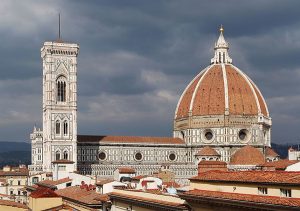
Florence, Italy. Photo: Felix König, via Wikimedia Commons
Art historians interested in these exchanges can get involved now with the ongoing dialogue. The Call for Chairs for the Florence CIHA 2019 conference has been posted and is open to all (Deadline: April 15, 2018); the Italian Committee has chosen the theme of “Motion: Transformation” as its interpretation of the broader focus on mobilities. The chair selection will be followed by a Call for Papers in Fall 2018. The Brazilian Committee will first issue a Call for Sessions between October and December 2018; the Call for Chairs will be issued in February 2019; the Call for Papers will take place between May and August 2019 with the final program being posted in October 2019. NCHA is developing programming for the CAA 2019 Annual Conference to advertise these conferences and encourage US participation. Stay connected with NCHA and check out the CIHA website for further information! We will continue to post updates in CAA News as well.
CIHA is the oldest continuously held art history conference in the world. In addition to its congresses held every four years, it also sponsors colloquia: more focused gatherings around particular art historical themes that are sponsored by its national committees. On November 27-30, 2018, India will be holding its first colloquium on the topic of “Art, Design, and Society.” Note that the Call for Papers closes May 7, 2018, so there is still time to participate in this conference. Following this, Japan will be organizing another colloquium in 2019 titled “Towards the Future: Museums and Art History in East Asia.” More information will be available as details are finalized. As the colloquia and the congress indicate, there are many opportunities for US art historians to get involved with these international exchanges of ideas.
New in caa.reviews
posted by CAA — Mar 16, 2018
Lisa Lee reviews Something to Take My Place: The Art of Lonnie Holley by Bernard Herman. Read the full review at caa.reviews.
Frédérique Baumgartner examines Delacroix and His Forgotten World: The Origins of Romantic Painting by Margaret MacNamidhe. Read the full review at caa.reviews.
Scott Volz writes about Art in the Anthropocene: Encounters Among Aesthetics, Politics, Environments and Epistemologies edited by Heather Davis and Etienne Turpin, as well as Against the Anthropocene: Visual Culture and Environment Today by T. J. Demos. Read the full review at caa.reviews.
Alison Syme discusses Otherwise: Imagining Queer Feminist Art Histories by Amelia Jones and Erin Silver. Read the full review at caa.reviews.
James A. Doyle considers Art and Myth of the Ancient Maya by Oswaldo Chinchilla Mazariegos. Read the full review at caa.reviews.
Ryan Donovan Purcell explores The Urbanism of Frank Lloyd Wright by Neil Levine. Read the full review at caa.reviews.
Chelsea Weathers writes about Working Conditions: The Writings of Hans Haacke edited by Alexander Alberro. Read the full review at caa.reviews.
Seung Yeon Sang reviews Public Properties: Museums in Imperial Japan by Noriko Aso. Read the full review at caa.reviews.
Louise Mayhew examines O’Keeffe, Preston, Cossington Smith: Making Modernism edited by Lesley Harding and Denise Mimmocchi. Read the full review at caa.reviews.



